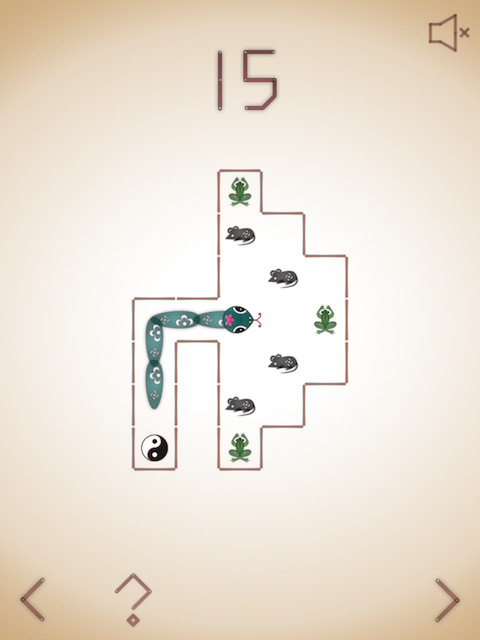Apr 2022 updates: added Snake Dance
July 2021 updates: added games Anhinga and Upaon, author’s text for Room to Grow, and a few new games to the omissions section
Here is a collection of all the snake puzzle games known to humans. (The snakes, we believe, are unaware and also cannot feel pain) I’ll try to write an update whenever a new game is released. The purpose of this article
Table of Contents
- Table of Contents (YOU ARE HERE)
- The Games
- Awards
- Ultra-Handy Quick-Reference Table
- Games coming in the future
- Omissions
- Discussion (the worst part)
The Games
Here are all the games, each with my description of them, a picture, and words from the designer. The ordering of the games in the main list is roughly the order that I played them in. There is a table afterwards that lists them in chronological order, and a drop-down menu right below this paragraph that has them listed alphabetically. My main qualification to write about these games is that I have solved all the puzzles. In describing them, I have sometimes left out key mechanics or high points, so that the reader will not lose the joy of discovery. If you find that I have erred too far to the side of spoiler avoidance, don’t tell me!
Dropdown navigation list (click here)
8 Happy Snakes
Anhinga
Avis Anguis
Blocker Snake
Boa
Bottom Feeder
Circle Serpent
Colour-Wriggle Mazes
Crate Snake
Crocodiles Love Cookies
der Hydra Krypta
Dotsnake
ENIGMASH
Extreme TJ-Wriggle
FillerSnake
Hungry Kraken
Lime Richard
Lime Rick
Monty's Way Home
Mortal Snake
Ouroboros' Eggs
Puddle Knights
Pushy Worm
Puzzle Snake
Quetzalcoatl
Room to Grow
Serpent Fusion
Shackle
Shall We Golf?
Shitstain
Shy Snake
Snake Blocks
Snake Dance
Snake Escape
Snake Maze
Snake Slider
Snake Sokoban Spiral
Snake Trail
Snakebird
Snakebird Fan-Edition
Snakebird GB
Snakebird Primer
Snakefall
Snakehole
SnakekanS
Snakeoban (Jack Lance)
Snakeoban (TeamDoodz)
Snakeoban (Wayne Myers)
SnakePace
Snake's Tale
Snakes without Brakes
Snakeshit
Snakey Jakey
Snakey Snakey Makes a Sixy
Snaliens
Snek
SNIKS
Snortal
Sokoboros
The Tail of the Serpent
The Turing Snake
Tile Snake
TJ-Wriggle
Train Snaking
Unconventional Guns
Upaon: A Snake's Journey
Vertebrae
Volcano Snek
Worm Jazz
Wriggle
Wriggle 3D
Wriggler Demake
Snakebird by Noumenon Games
The most well-known of the snake puzzle games, and for good reason. The mechanics are deep and intriguing, and the game is well polished, with good levels and some of the best graphics of any 2D puzzle game. The main novelty is combining snake movement with gravity, and it also has growth by eating fruit, pushing blocks of different shapes, and the ability to individually control multiple snakebirds. My favorite trailer/video of Snakebird is this one (warning obscene language), which might be funniest if you watch after playing a few levels first. There is also an in-depth article by ElectronDance about his experience playing through Snakebird. Snakebird has great puzzles that reward planning ahead, and visualizing the shapes you will need to make in order to solve them. Its difficulty catches some by surprise, as the visuals look playful and benign. It’s not the hardest of the games here but it’s harder than average. Overall it gets a very high recommendation! The creation of the game is discussed by its developers here
Snakebird has inspired several other entires on this list, including a sequel, a number of fan-made level editors, and a couple of spinoffs in PuzzleScript, and I will describe each of those below. One amusing new addition that won’t have its own entry is a Snakebird level done in Baba is You!
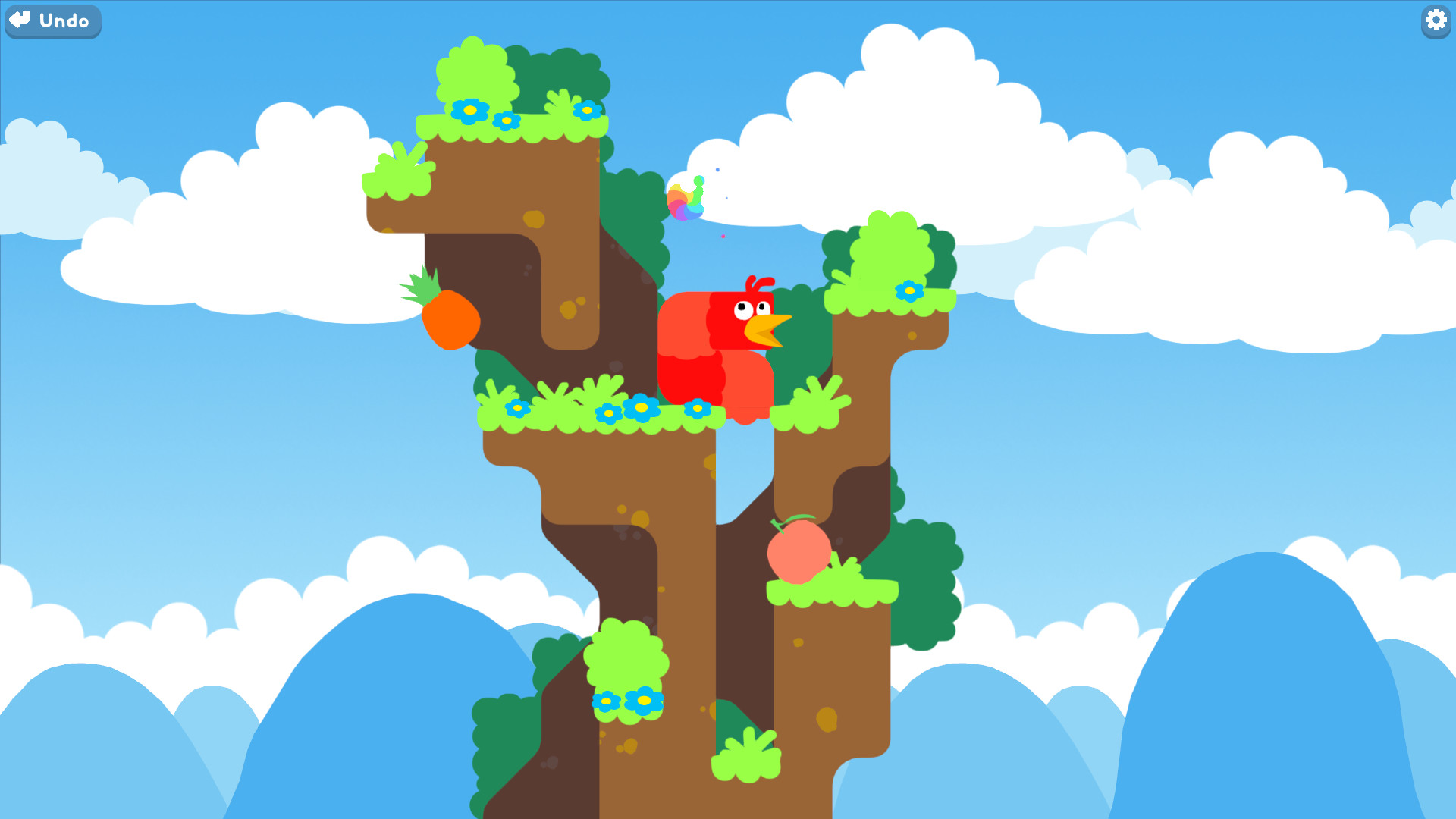
The idea came from misunderstanding how a game by a friend worked. My friend only linked screenshots and never actually described how it played, so when it later turned out that his game was in fact a platformer and not actually a snake game with gravity like I had thought I made a prototype to show him. The prototype was then sort of forgotten about and it would take about a year before we dug it up and started turning it into a proper game.
-Felix
Snakebird Primer by Noumenon Games
A newer game from the makers of Snakebird that uses the same mechanics, designed as an easier version that will either serve as a warm-up to the original game, or just a gentler experience. Aside from the different puzzles, the game is very similar to the original in terms of structure, aesthetics, and gameplay. It’s quite a bit simpler, the difficulty being on par with the first 5-10 levels of Snakebird, so for those who have completed the original game this will not add much. But if you found the original Snakebird too difficult, there’s a good chance you will enjoy this version.
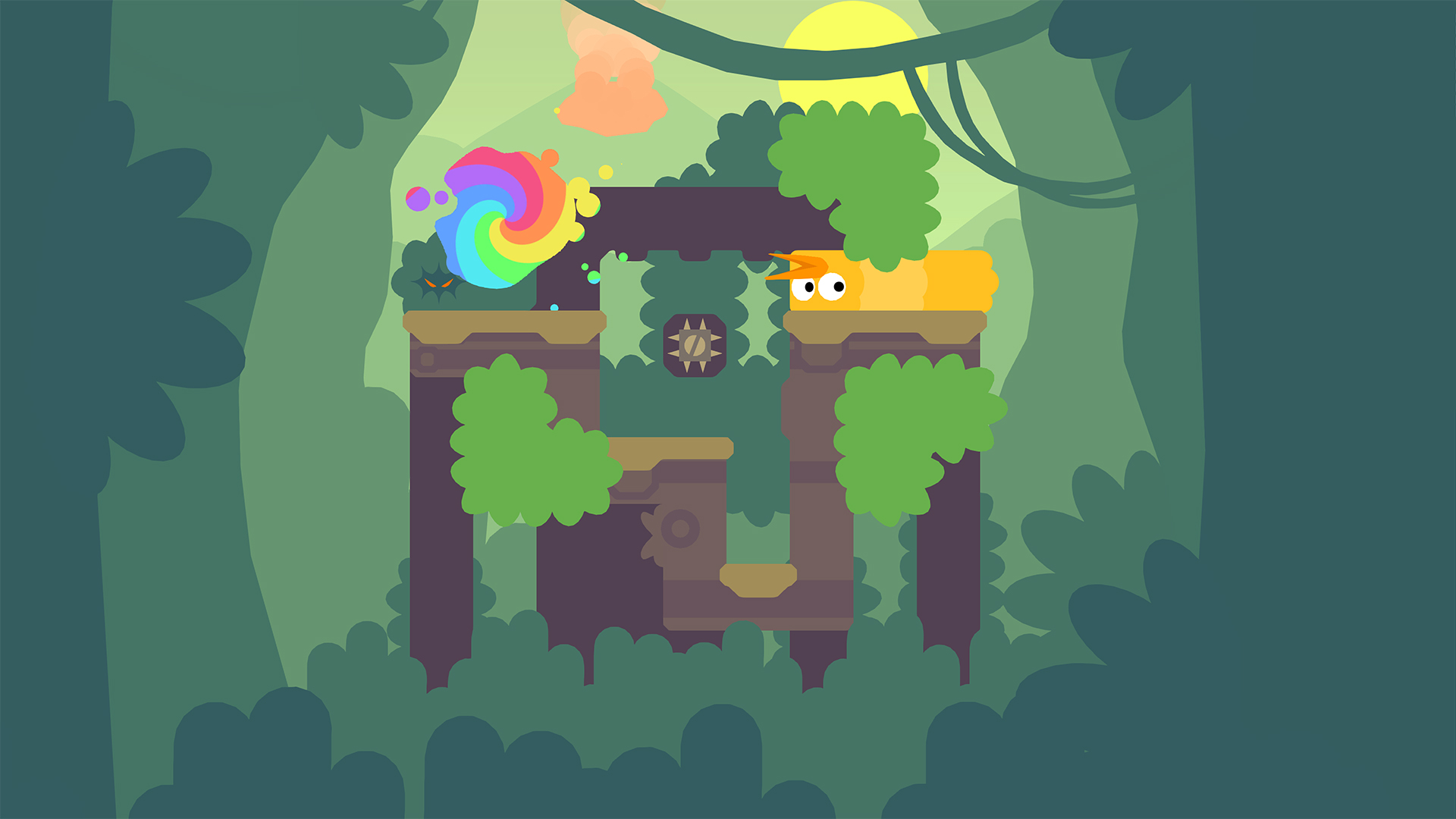
Snakebird GB by freeball1
A remake of Snakebird done by a friend of the designer, strangely made for Gameboy. It comes with 10 original levels clothed in retro graphics. The new levels are well designed, are on average a bit more challenging than the original Snakebird, and have a clearly different puzzle style as well. The lack of an undo button can sometimes get annoying, but is overcome with a bit of patience. Based on a quick Google search, I ended up using the openemu emulator, and it worked well. Definitely recommended if you like Snakebird.

Snakefall by thejoshwolfe and contributors
There are three fan remakes of Snakebird that were built specifically to have a level editor. Snakefall was developed by thejoshwolfe and is the most successful of the three. There are by far the greatest number of levels built in Snakefall (currently 95), and they are generally the most difficult as well. One new thing in this version that is not present in any other Snakebird variant is one-segment snakes. Try out how these work in the first level, Disabilities Act! (pictured below). The hardest level sets are by Teal Knight, Gooby, and Karoo13, while an easier set of 3 was made by Cookie. The difficulty of puzzles by other designers is mostly in the middle.
The overall quality of levels designed in Snakefall is surprisingly high, with the lone blemish being 6 levels by eff96 that include puzzles copied without recognition. Stand-out levels for novelty of concept or interesting solutons include (in order of appearance in the wiki): Etch-a-sketch by inukoblainc, Spike Maze by XeroOl, The Ordeal by thejoshwolfe, There and Back Again by gavinksong, Level 1 by Dr Endugu, Level 3 “The Servant” by Teal Knight, Level 6 “Decisions” by Teal Knight, Mine Rescue by Gooby, Fruit Temple by XeroOl, Castle by Gooby, Quite The Obstacle by Karoo13, Heist by Karoo13, and Basalt by Karoo13.
There is an experimental section in the wiki, with a few new mechanics introduced. The first and main one is a type of platform that allows snakes to move up through it, but not down; a snake is supported on the platform by any of its outside edges. It takes a bit of experimentation to fully understand the rule, but it works well for the puzzles. This mechanic is explored thoroughly in an ordered set of levels starting with Under Cover by XeroOl and increasing in complexity until the vicious Prison Escape Extreme by Karoo13 and my Alcatraz. See the note next to Under Cover on the wiki for the playing order. Another level of extreme difficulty is Puppet Master’s Revenge by Karoo13, based on The Puppet Master by Gooby. It uses sideways platforms as a way to prevent unintended solutions, and while that’s not the most elegant fix for that type of problem, the resulting puzzle is brilliant. Another intricate and thematic level using platforms is House on Fire by Gooby. Gateway to Freedom by LevelWorld introduced gates, and while their individual potential wasn’t explored to the fullest in that level nor others since, gates did turn out to be a useful tool in constraining unwanted solutions (and are used for that purpose in Prison Escape Extreme and Alcatraz). Underground by Gooby is a cute level that uses diggable dirt terrain.
I have added my own difficult puzzle, Temple. I also made some other contributions that you can find on the wiki, mostly in the form of modified levels. If you’d like to give them a try, I recommend solving their predecessors first.
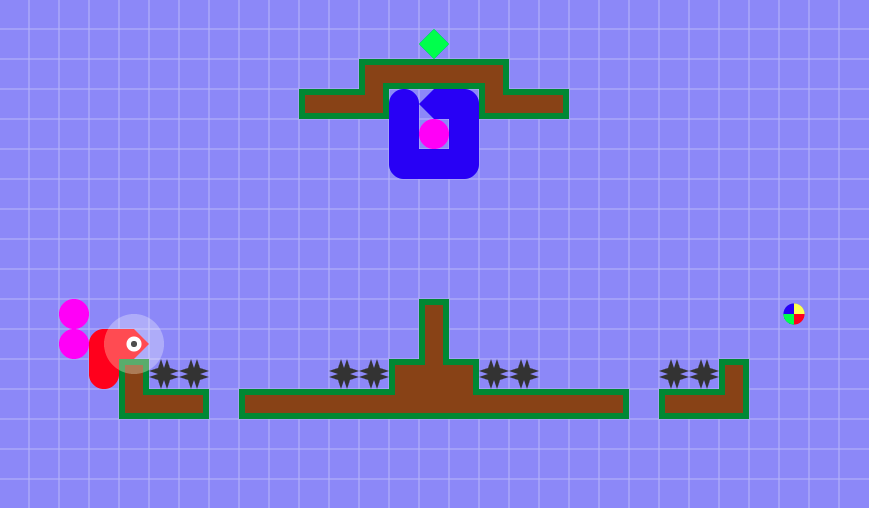
Avis Anguis by Terzalo and contributors
The second reimplementation of Snakebird, this time in PuzzleScript. Terzalo programmed it and made one level for it, and a few others have made some levels for it. The editor that can be used to make levels is here. The first level made is Terzalo’s single demo level, which is large and demonstrates all of the mechanics from the original game. Connorses made two levels, here and here. The first level is novel and interesting, and the second more standard. I think the best is this set of three levels by CHz. The first two are on the easier side while the third is challenging and quite nice. As you can see below, the graphics leave much to be desired; but it’s clearly readable once you start playing with it.

Snakebird Fan-Edition by Jacob Munch-Andersen and contributors
The last remake of Snakebird for fan levels, this one has 5 levels by the programmer (Jacob Christian Munch-Andersen), and two other levels that I know of. When you first take the link, there should be the original 5 levels on a drop-down menu on the right; additional levels only show up once you have taken a link to them. The first 5 levels are elegant and about the same difficulty as original Snakebird, and the two contibuted levels are slightly harder. Fruit Transport by Edderiofer and Jacob Munch-Andersen has “fruit-crates” that must be pushed into the exit (they are essentially 1-segment snakes that were deemed immobile), and Wall by Jack Lance is a very nice level with standard rules.
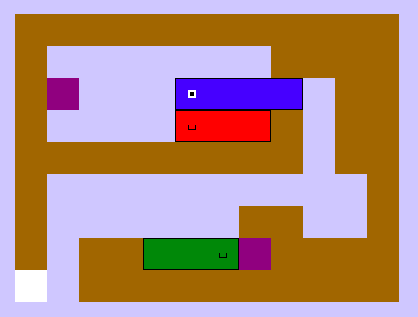
Anhinga by Nathan Sturtevant and lab
Did you know that an anhinga is an animal that has the nickname “snakebird”? You probably did not, which is one of the many reasons why Dr. Nathan Sturtevant of the University of Alberta believes we need more artificial intelligence in the puzzle game industry.
Another reason was to see how computational power can help puzzle designers iterate and improve on their work. With the Anhinga engine, you can see what single tile alteration in a Snakebird puzzle causes the greatest change to its optimal solution length. Although solution length is not the best metric for how interesting a puzzle is, the hypothesis was that it could at least unearth some interesting tricks that the designer was not aware of. The Anhinga developers applied the solution length extender function twice (in series) to every level in Snakebird and Snakebird Primer, and have published the 7 puzzles that changed the most on the linked page. While a few of them don’t change in interesting ways (and are therefore perhaps more tedious than the originals), a couple certainly have. Modified Primer 65 became intricate while still being playful, and Modified Snakebird 24 (pictured below) is magnificent.
If you’d like to try your hand, there is an ongoing study where participants try to use the Anhinga engine to make their own Snakebird puzzles. The papers about Anhinga hosted on the website may also be of interest, including a funny discovery in the incremental design changes link, figure 2.
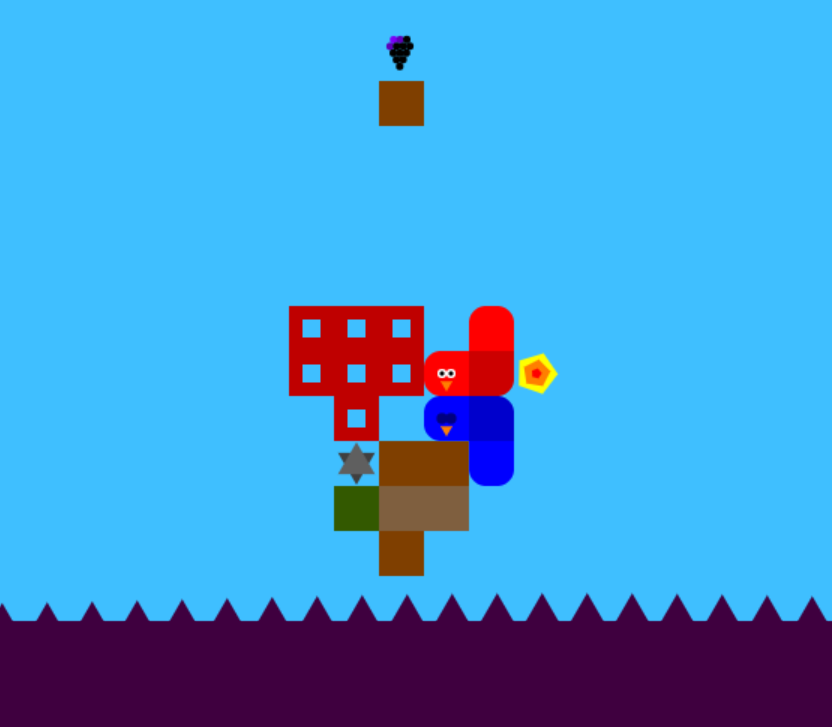
How did you choose Snakebird?
I started thinking about this sort of analysis back in 2013. We did puzzles for the Witness a few years ago, so I was thinking about other games that could use similar techniques for analysis. Snakebird seemed to be a good candidate where humans are not good at predicting the impact of changes to a level, so computers would be able to help. I started by having a visiting student code up an implementation. After it showed things could work reasonably well I wrote my own implementation which is far more efficient (both memory- and time-wise) and started using it to analyze levels.
Was it clear to you that searching the space of all single tile alterations would be feasible before you coded it? (my own guess would have been no)
No, I didn’t know if we’d be able to do this for sure, or that we’d get such interesting results. Originally I was hoping to build an editor that would help someone build better levels. (Which worked for the student doing the initial implementation.) But, as we explored, we found this angle for our first step in the work. We are working on studying how the editor helps designers next.
I’m curious if you had thought of using other metrics besides solution length.
I’ve talked with colleagues about different metrics, but I haven’t had to use them yet. But, I think there is room to use them. If you look at this level, the shortest solution is not one that most people would use. So, the suggested change to this level is not particularly interesting, while this variant of the level is much harder for people. Playing around, I can (with the help of the editor) come up with this variant, which is much more difficult still. So, I think there is room to use better metrics, but we aren’t doing it yet.
-Nathan Sturtevant
SnakeShit by Dario Zubović
Designed by Dario Zubović as a cross between Snakebird and ShitSnake (a whimsy by Draknek that is not a puzzle game), it’s a short but interesting variation of Snakebird. I will let you guess as to the mechanics!
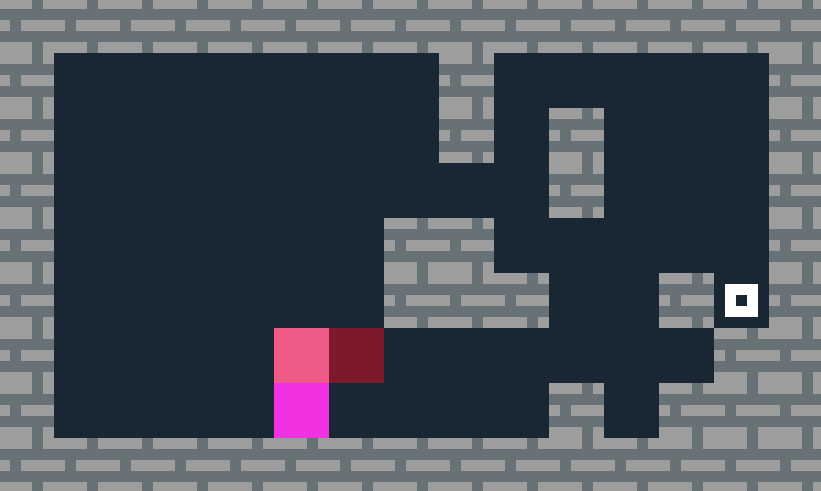
ShitStain by Dario Zubović
Another game by Dario Zubović that is a kind of sequel to SnakeShit. This one makes a small change to the mechanics that allows for different, interesting puzzles. It’s only two puzzles long, the first to demonstrate the mechanics and the second to offer a challenge. Both of these games are quite amusing and worth playing.

Those first two are literally shit games tho, idk why you’re including them
-Dario Zubović
Pushy Worm by Sid Fish Games
Made for a 1-week game jam with the theme “Collectables,” this Snakebird inspired puzzle game has you grabbing fruit with your head and bringing it back to your nest to feed three hungy snakelets. Collecting objects with your head takes some getting used to, and it took me a bit of time to realize that pressing down throws the food off your head. Another addition to the snakebird mechanics is trellises that you can slither around to gain height. Overall quite a cute game, with mostly simple puzzles.
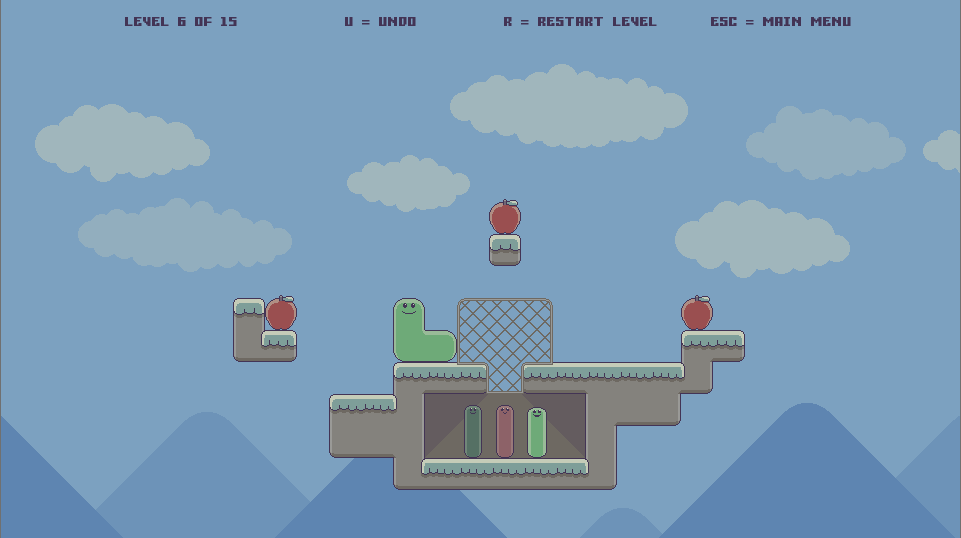
Volcano Snek by JUSTCAMH
Though not consciously inspired by Snakebird, Volcano Snek is a “micro metroidvania” (short and you gain powers as you progress) that uses similar snake plus gravity movement. The new idea is that you can raise the lava level within a puzzle by knocking your head against a wall of the volcano. The ability to affect the ground in this way is interesting, though the puzzles are mostly simple and I think the possibilities have not been fully explored. Not unexpected given that this game was made in 48 hours for a game jam (that it won!). This is the last of the Snakebird-like games on the list.
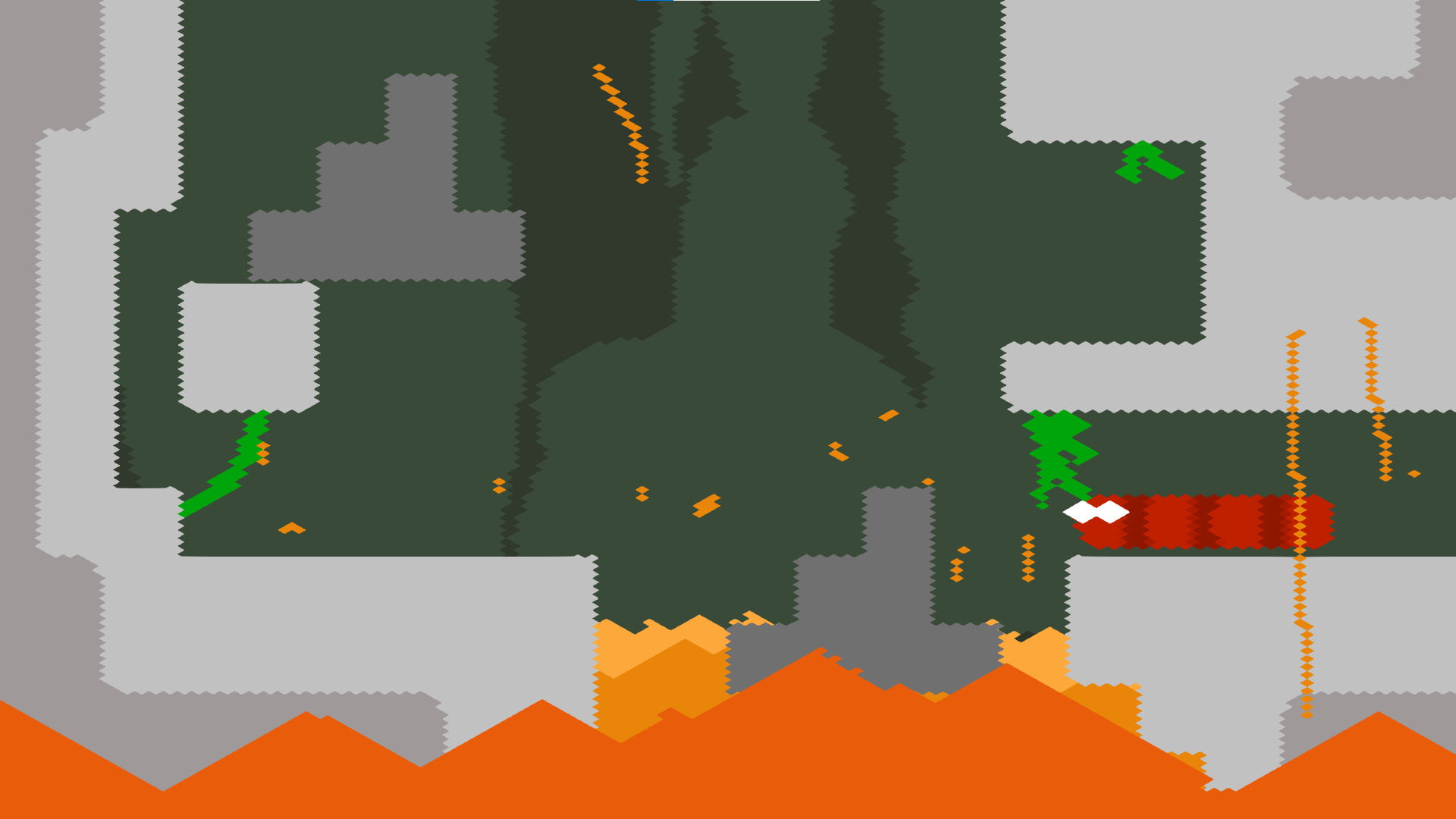
Blocker Snake by Rosden Shadow
One of Rosden Shadow’s game-a-day that he kept up for a remarkable 87 days, it’s short but unique. Your snake picks up segments like usual, except these segments block the snake’s movement more than in regular snake. Worth trying, though it doesn’t match his most impressive game from the game-a-day endeavor, which is Islands.
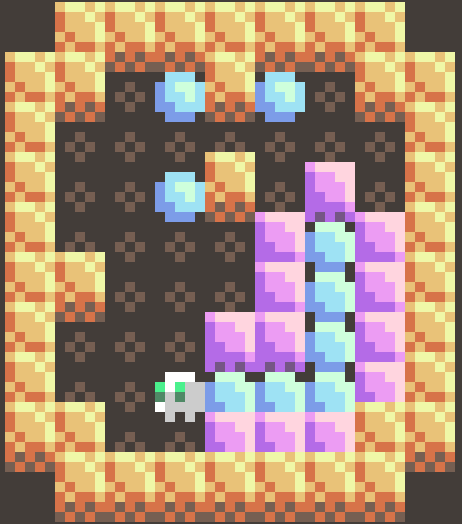
I would have chosen to use a snake game to use as a puzzle game because I was working with every little idea I could think of. I chose to have the goal to collect all the orbs and having the orbs extend the snake and create walls because when it comes to snake games most of them are about navigating through or avoiding the wall/body that get in the way by your own movements and those mechanics worked towards enhancing and taking advantage of that effect.
-Rosden Shadow
Ouroboros’ Eggs by Marcos Donnantuoni
A game where your snake lays eggs if it makes a loop around empty space, and each puzzle asks you to lay a certain number of eggs in the given terrain. As with many of Marcos Donnantuoni’s games, the puzzles here were procedurally generated, though you might not have been able to tell based on just the level design. It’s an interesting take on snake puzzles, certainly feeling different and worth trying. There is variety in the solutions, but maybe not quite enough to justify the large number of puzzles in the game. There are a few other puzzles game by different designers that are about catching your tail, but mostly didn’t get past the work-in-progress phase: In [Ouroboros] by Connorses (https://www.puzzlescript.net/play.html?p=10346416), the only goal is to catch your tail. This is made nontrivial by having more complex maps, but it ends up feeling like mostly trial-and-error. The Ouroboros Labyrinth expands on that theme by having your snake shrink to its minimum length each time you eat your tail, and you must shrink to nothing in stages. Ouroboros by Grogge adds some lock & keys, and blocks that mimic your snake’s movement. Your tail stays put, so it feels more like the exit is coincidentally where you start, rather than chasing your tail. Unfortunately it also seems to add at least one major bug. Ouroboros by CaptAndrey has blue and red pellets that you eat to grow, and you must eat a blue segment that is part of your body in order to win. OuroBOOros by NekuSoul has you play a ghost that pushes rocks into the AI-controlled snake’s way so that it changes paths, resulting in eating eggs to grow or eating its tail to complete the level. OUROBOROS is a minimalist “2-5 minute” puzzle experience that is a … 450 MB download?? I haven’t tried it. Overall Ouroboros’ Eggs is the most interesting exploration of the tail-eating idea.
If you are interested in procedurally generated puzzle games, Marcos has made many other good ones – my favorites include Always With the Magnets, Seq-O-Ban, and Dis Pontibus. (incidentally, Dis Pontibus has a small snake movement component too!)
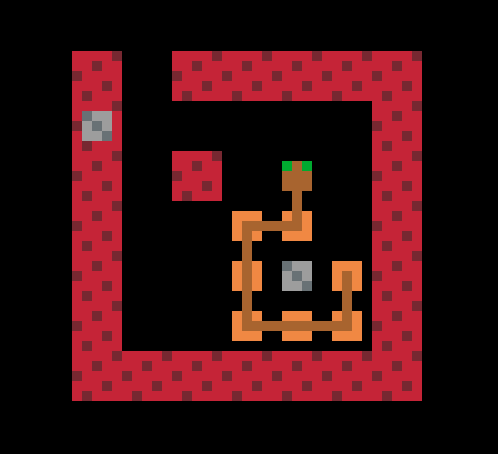
Ouroboros’ eggs uses a mechanic that I planned to use in a larger game, which was going to contain several mythological serpents, each with different powers that manifested differently. In particular, the Ouroboros activates its power (laying eggs to reproduce) each time it closes in a loop, biting herself. This is an interesting topological idea, but constricting it to a grid made it a little more simplistic than I wanted to achieve. However, I was able to generate some interesting levels. In particular my favorites are those where laying the required amount of eggs is very straightforward, but the challenge is to do it in a way that allows you to get out of the burrow.
-Marcos Donnantuoni
Snakehole by Jack Kutilek
Snakehole is a very interesting take on snake puzzles. As you might have guessed, there are “holes” that play a big role in the mechanics. Exactly how, you’ll need to find out for yourself! I will just say that it interacts perfectly with the classic snake puzzle stlyle - it feels natural despite being a big change. Snakehole only has 8 levels, but each one is large and meaty. It is also has some of the nicest visuals in a PuzzleScript game (I guess the bar is low, but it’s pretty hard to make 5x5 pixels look good). This is one of my favorite snake games on this list, having both creative mechanics and good puzzles. I made a silly modification to level 7 that makes it harder, but not in a good way (I previously had a higher opinion of it).
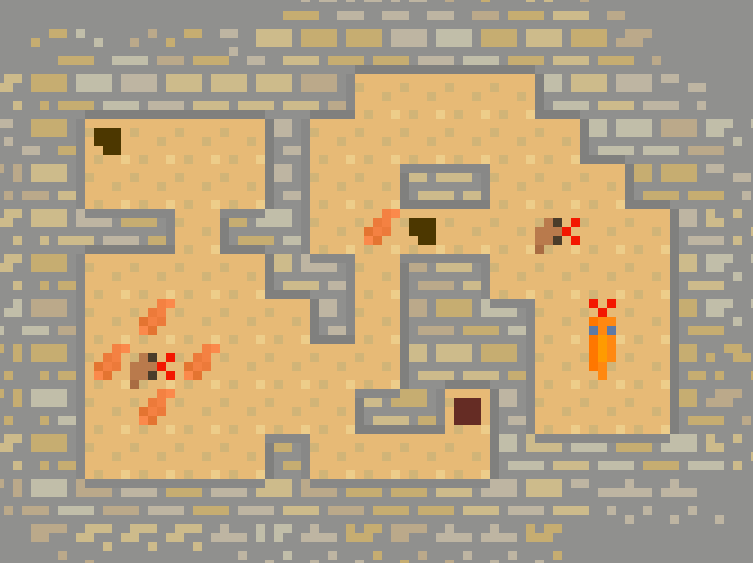
Snakehole spun out of a discussion about how you might implement snake-like movement in puzzlescript. I put together a quick demo, and once I had a nice snake of course I needed a crate to push around. I was interested in symmetric objects and mechanics, so of course the crate needed to be a snake, too. I introduced the hole as a way to get through tight spaces with a long snake, and I continued adapting its uses as I needed more mechanics for my level designs. I also used this game to practice pacing - inspired by the sequencing technique described in ‘Every Frame a Painting’s video on ‘F for Fake’, I designed multipart levels with alternating and developing themes. The goal of this was to create frequent, structured variation in gameplay while the full consequences of the mechanics are explored and shared with the player.
-Jack Kutilek
Snakeoban by Jack Lance
This wonderful PuzzleScript game is not well known, but the puzzles are fantastic. The mechanics involve controlling a snake on a flat plane and eating apples to grow, but in addition to eating all the apples, your goal is to place boxes on all the targets. The idea was first done by the other “Snakeoban” below this one, and Jack Lance expanded on it by adding simultaneous movement of multiple snakes, as well as blocks of different shape than 1x1. Normally I am not excited by simultaneous movement puzzles, but Jack crafted puzzles that are much more deductive than fiddly. I found this to be one of the best PuzzleScript games out there, and it gets quite challenging in later levels. The penultimate level is one of my favorite sokoban puzzles. Note, the itch version linked here contains more levels than earlier iterations of the game had, in case you’ve played it before.
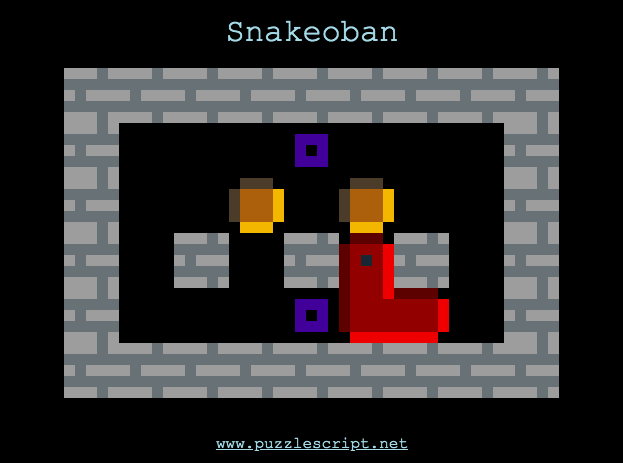
The level I remember liking the most was the one where [rot13] gur jubyr fanxr jnf genccrq va n yvggyr obk gung lbh unq gb zbir nebhaq gur ebbz. Just because it totally flipped expectations of what gur obkrf had been used for.
-Jack Lance
Snakeoban by Wayne Myers
Similar mechanics to the early levels in Jack Lance’s game, but the puzzles here are easier and not quite as tightly designed. I would recommend this mostly if you like the snakeoban idea and would prefer an easier game to Jack Lance’s. This one gets credit for being the first game to combine snake movement and pushing objects onto targets, which turned out to be quite interesting with several other variants of the idea to come later.
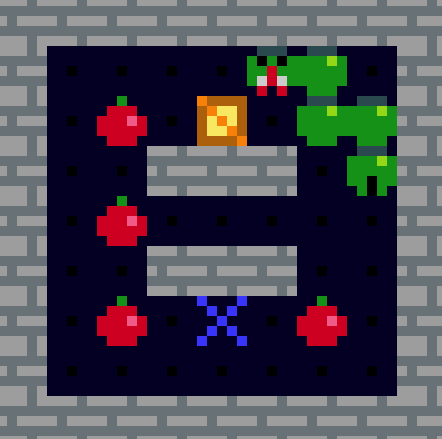
Sokoboros by Trevor Newton
A short, continuous game about growing from a baby snake into one of legendary size. You’ll be sitting over pressure plates to open doors, and growing your snake ever longer by eating fruit. Has a few easy puzzles and a few more involved ones by the end, and overall is very charming!

In many snake games, you eat and grow longer, and then you move to the next level and become a normal length again. I wanted to set a game in a single open world where you gradually become so absurdly long that you occupy multiple rooms at once.
-Trevor Newton
Dotsnake by Franklin Dyer
This game is like Snake in that you have to eat all of the food, but your snake has infinite length so it’s all about picking everything up and reaching the exit without retracing any steps. The puzzles in dotsnake tend to be quite simple. Mechanically, it’s actually identical to one of the puzzle types in The Witness. Infinite length lines/routes are often not snake themed at all, and my favorite puzzle games of that category are Draknek’s Cosmic Express and Jonah Ostroff’s Collect Gnocchi. Mr. Dyer also made another snake-like game, Jormungandr, but it was abandoned in an unsolvable state. The idea in Jormungadr is that your mythical serpent can cross the sea to visit other islands, but only in a straight line crossing over water. In the link provided, I added one land tile so that the game can be completed.

Circle Serpent by EvilArtBunny
A game where your tail stays put, and you need to eat enough to extend your body until you are able to reach your tail with your head. The graphics are nice and the music is soothing. Most of the puzzles are quite straightforward. Once you understand the rules, you can press ‘end’ to skip some of the early levels that I think are too straightforward. The basic mechanics don’t really suggest a snake theme, but when multiple snakes are added it makes more sense.

Snek Alpha / Snek by St33d
A snake game where the main difficulty is restricted controls. Rather than being able to move freely in all 4 directions, you can only press left or right. The trick to moving up and down is that left/right do something different when that direction is blocked. The goal is to cover all the target squares with blocks or yourself. The alpha version has a shorter snake, while the main version has longer snakes and few more levels. The two versions of the game don’t overlap, so you can play either of them or both (I found them about equal in enjoyableness). Snek is certainly interesting, but it takes a bit of time to get used to not being able to move in the direction you want to (at first it feels rather annoying!). The Fuse is another nice puzzle game from this author, as well as his rock-moving-brothers-quadrilogy (Flying Kick, Sokoslam, Drop Kick, Psykoban)
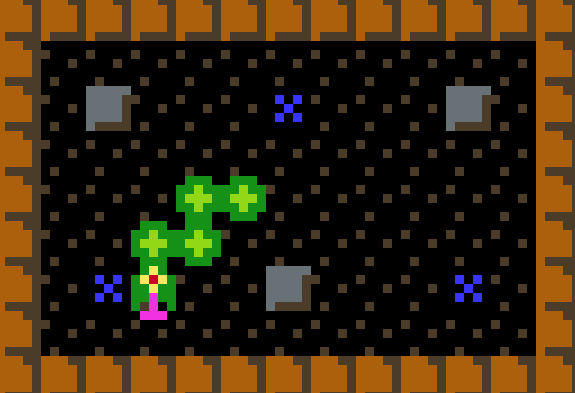
I was thinking of making a game where you move through a 3D space but with fewer axes of control. I reasoned that if having less inputs it worked in 2D, then it should work in 3D. It amused me but it didn’t grab me, so I made other things.
-St33d
Lime Rick by Tommi Tuovinen
An interesting snake game with gravity, where you need to eat all the apples and you have infinite length. The most common maneuver is to climb on your own body to reach greater heights, but there’s a lot more to it than that. It’s a longer game with many interesting levels, and adds two mechanics as the game progresses: locks and keys, and one that you might guess but I won’t reveal. While infinite length normally means it’s similar to line drawing, the fact that you fall with gravity makes it feel organic and snake-like.
There is a PuzzleScript implementation of the first 10 levels, and there is also a fan level of Lime Rick at the end of Simple Block Plagiarism Game, which changes one mechanic slightly. Two more Lime Rick inspired games appear in the entries just below.
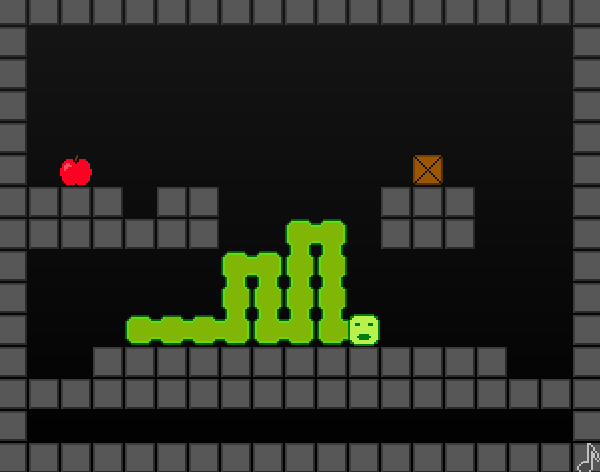
Lime Rick is actually pretty much an improved remake of my older game “I left myself behind” which I made for a certain game jam/compo. With keeping the time limit in mind I wanted to keep the concept as simple as possible and put the most of effort on making the puzzles interesting and compelling. I love coming up with challenging puzzles so after completing the game I started coming up with new levels. I felt that the original self-replicating straight-faced main character was somewhat awkward, so when upgrading the visuals a forever growing snake felt like a natural choice and the goal was changed to a red apple as in classical snake games.
-Tommi Tuovinen
Lime Richard by Franklin Dyer
A PuzzleScript fan variant of Lime Rick, it is quite short and plays with an extra couple of ideas. Give it a try if you liked Lime Rick, though the puzzle design is not as good as in the original.
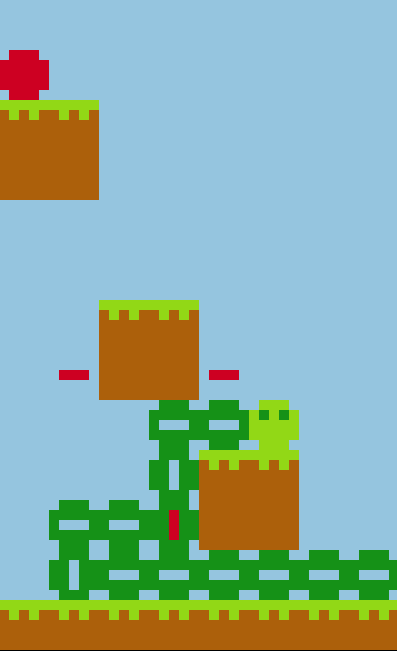
Snake Escape by Einar Sauskas
Snake Escape is a fan-remake of Lime Rick for the ZX Spectrum. Why would a modern game be made for the ZX Spectrum, you ask? Dear reader, please stop with the silly questions! Snake Escape is described as being based on Lime Rick, with a modified design including making the original hard levels harder, and adding 4 new extra hard levels at the end. I went through both games side by side, and can list out the pros and cons of this edition.
Pros: More interesting graphics; original music (Lime Rick didn’t have music); levels 9 and 30 are made harder and more interesting; 4 new levels at the end (these are about the same difficulty as the later levels in Lime Rick).
Cons: Need an emulator; no undo button; level 26 is easier and less interesting; on my machine at least, movement was slower (brief delay between key presses).
In order to play I used the Fuse emulator. To get the music running, select 128k machine in the options. The controls seem to be left = O, right = P, up = Q, restart = space. The levels are generally modified to be on a smaller grid, to make room for the more interesting graphics of each tile. Most levels turn out to have basically the same solution as in Lime Rick, with the exceptions noted above. Although the mechanics and most levels are derived from Lime Rick, it has the blessings of Lime Rick creator Tommi Tuovinen (which I confirmed).
Bas de Reuver had an interesting idea to expand the game, which he demonstrated in a short prototype called Snake Escape 2, but it didn’t catch.
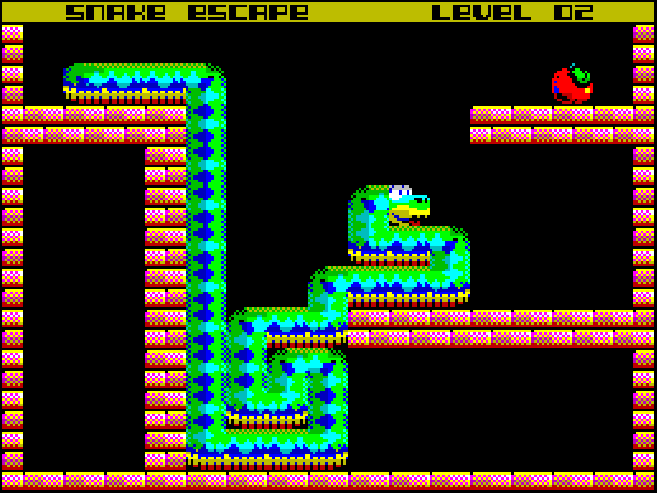
8 Happy Snakes by Stephen Lavelle
A small snake game with 8 levels, where snakes grow indefinitely and you want them in a specific shape. It has one main twist that I won’t reveal. Fun game but goes by quickly.
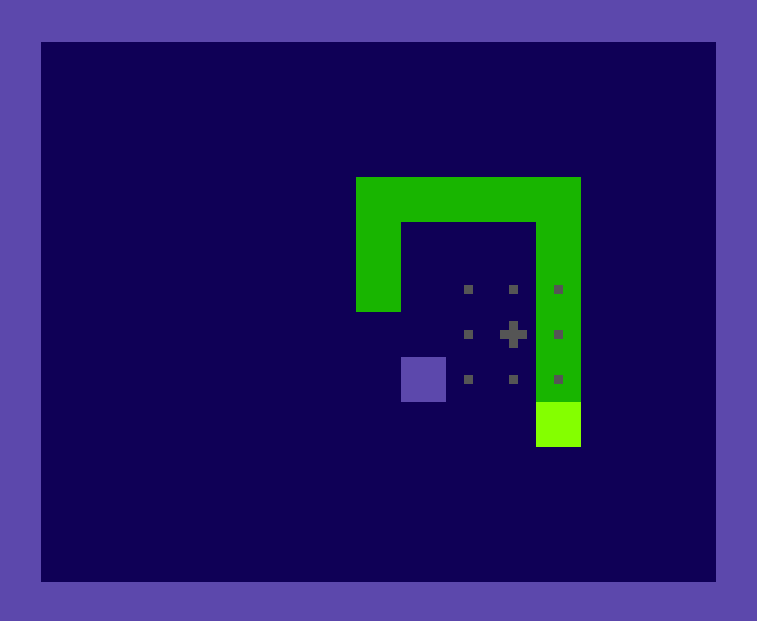
Unconventional Guns by Rectangular Tim
This short game could be separated into two parts for the two unconventional weapons. The first weapon is a snake gun, which shoots out a snake that travels until it hits an obstacle (and then can move in another direction). Use it to kill zombies! A fun little game that still poses a challenge.
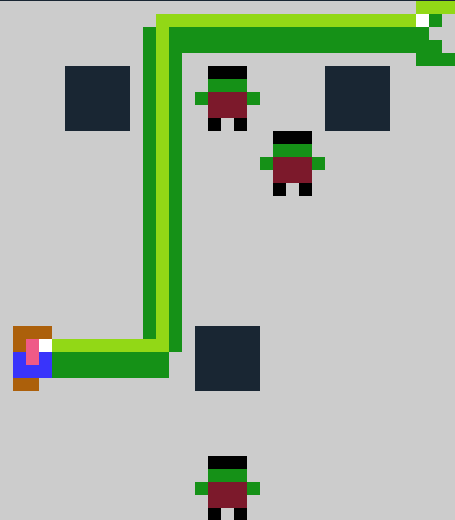
Boa by Steven Miller
A neat snake game that feels like somewhat like an adventure since the levels are large. Puzzles are a bit hit-and-miss; some puzzles are nice and some less interesting. Adds several adventure-like mechanics, which I won’t spoil all of. One mechanism that works quite well though is “falling,” where your snake needs to be on top of at least one land tile in order to not fall. This is like a 2D plane version of falling in Snakebird, which worked very well. Since none of the puzzles are too hard, the game is relatively short.
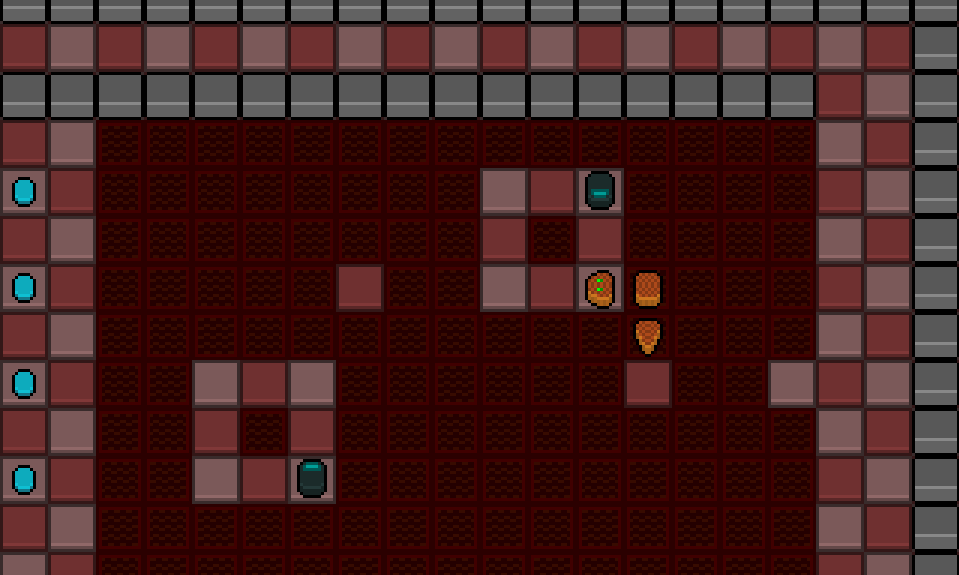
Boa was my first puzzle game, and it often shows through odd pacing and difficulty drops. It was created for MiniLD 63, the theme for which was to take a classic game and give it a twist. I went with snake on a whim. At that point, I hadn’t seriously played sokoban or its variants, so the mechanics were pulled from more casual games. As it was my first foray into the genre, it wasn’t very well thought out, resulting in somewhat awkward gameplay.
-Steven
Snake Trail by Steven Miller
In this game you control both a snake and a square, and the snake is used as a raft to assist the square in moving around and pushing things. Nice idea! Not too many puzzles but the later ones are good.
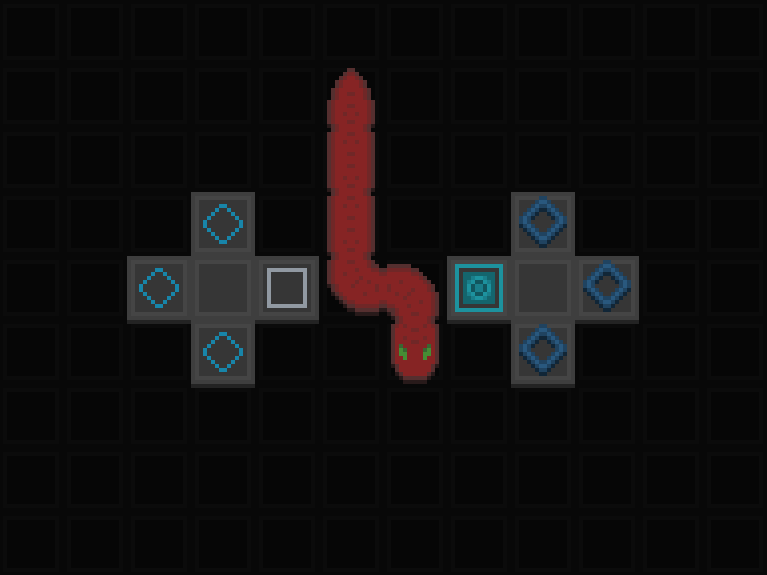
Snake Trail was my attempt at a game where the snake increased the freedom of player movement. I had somewhat recently played Snakebird, so I wanted to try something with snakes again, but I wasn’t too fond of how restrictive the snake character is. Instead of having the snake segments clutter the movement space, I made it part of the movement space.
-Steven
Crate Snake by Steven Miller
An interesting snake game where you need to push crates onto targets (like “Snakeoban”), but here your snake can wrap around the screen (using torus topology). Some of the puzzles are not that tight, in the sense that target squares could have been put in different locations without changing the solution too much. It’s still pretty fun though.
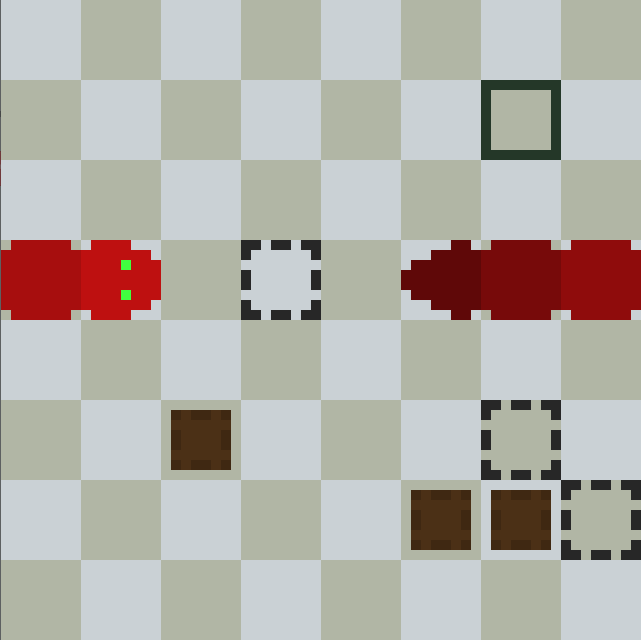
The next snake game I worked on was Crate Snake. At the time, I was experimenting a lot with different movement mechanics, one of which was screen wrapping. The idea was to have the character’s length restrict movement but have the screen wrapping compensate by allowing more ways to avoid getting stuck. I was unhappy with the result and I actually abandoned the project for a while despite it being almost done. I released it almost 6 months later for the Finally Finish Something jam nearly unchanged.
-Steven
These three games above were made by Steven Miller, whose best games I think are Vampire Garden (a fantastic, deep puzzle game that has nothing to do with snakes) and Shackle which you will find lower down. He also made another game called Snake Blocks that I am not reviewing only because he has a major overhaul planned. I expect it will be very good!
Snake Maze by ZilverPhoenix
Does feel very much like a snake maze - how do I escape from this labyrinth of walls, buttons, and doors? - and the 10 levels in the base game are mostly interesting. Because the mechanics are basic, the main one being sitting on buttons with any part of your snake in order to open doors, the difficulty comes from having a lot of things to keep track of in the level. Manages to still be good overall though, and the levels are well designed. There is a bonus level pack of 10 extra levels, which is described as being more difficult and experimental, though I found the difficulty and style to be not far off the base 10 levels. I did slightly prefer the design of the extra levels, some having more open areas and other interesting geometries.

I was thinking of different existing games and how their mechanics could be extended upon, one such game being Snake. The idea of a snake pressing buttons just came to me, and since I couldn’t find any games that used this mechanic, I decided I must create it myself. I think the idea was great but I acknowledge that my sadistic level design and lacking amount of additional mechanics scares many players off.
-ZilverPhoenix
The Tail of the Serpent by Lucas Le Slo
Each of the segments of your snake are different symbols in this twist on snake games, and you need to match the segments to target squares on the ground. Also, instead of having your tail block movement as in most snake puzzles, here you can eat yourself, resulting in rearrangement of the symbols. A fresh feeling game with really good level design that keeps things small and elegant. It was done for a Ludum Dare with the theme “your life is currency” and this game fit the theme incredibly well! If you already played the Ludum Dare version, I recommend replaying the whole game, as most of the levels have been redone and are of much higher quality now. I must also mention two other puzzle games by Le Slo that are wonderful despite their dearth of snakes: Flockoban and Metamorphosis.
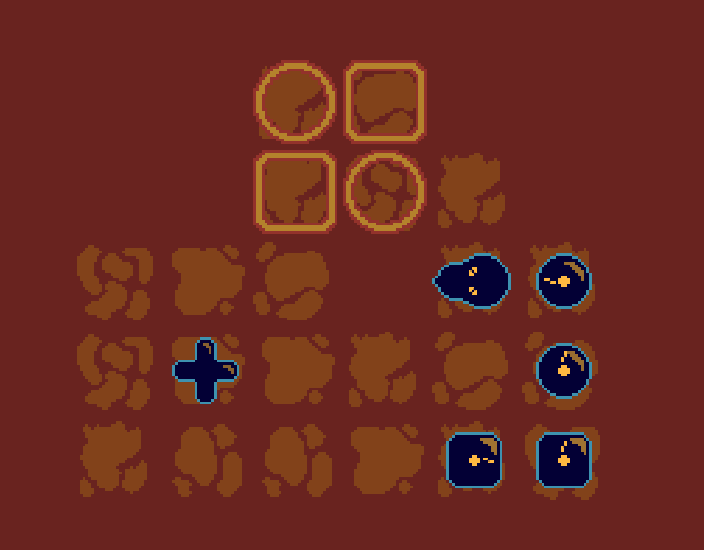
The theme of the jam was “Your Life is Currency”, I wanted to avoid classic interpretations so I spent most of the first day thinking. The string to pull was: a snake that pays with his body, at that moment it could be enemies with patterns, switches and doors or a weird metroidvania. Experimenting with eating your own body and leaving the tail behind pushed me to make this a puzzle game, so I spend most of the second day migrating everything to my level editor. At the end I was still confused by the eat yourself mechanic, levels were a bit random and wasn’t completely pleased with the general difficulty. Laying at night, looking at the floor, the push mechanic appeared to me and I decided “I need to add this tomorrow morning to the game” before falling asleep, I was glad the system surprised me that way. That caused having little time the third day to design levels, especially with the eat yourself mechanic, because I already explored it a bit.
I’m actually very happy with the result (not only the system but the aesthetic and music), I managed to make in 3 days a coherent game. I replayed it a couple of times and started finding unintended solution and redundancy between levels, of course. I gave me the 3 weeks of rating games to redesign the puzzles, finding new ideas (wow, new ideas! I couldn’t believe it) and fixing a couple of bugs. Although I’m pleased with the new levels, I think I messed up a bit the level order (classic!) and nowadays I would permute a couple of the levels. I believe that this is the game I made with the highest puzzle-theorem rate in spite of puzzle-example and I hope in the future I come up with ideas like this, that doesn’t only puzzle the players during their playthroughs but surprise me while making them. Ah, and I absolutely love level 25, it’s the best level I ever designed. [editor’s note: by puzzle-theorem he means a puzzle that requires a new discovery or insight to solve, as opposed to a puzzle-example which is an application of something already learned]
-Le Slo
Snake’s Tale by Michael Fairley
Nice graphics and a good set of mechanics. The objective in each puzzle is to get a specific snake to a goal, while other snakes (that you also control) get in the way. Several more mechanics are introduced later, and they complement each other quite well (pressure plates, eggs to eat and grow, different terrain, and more). The puzzles themselves are on the easier side but many are interesting. Controls were surprisingly natural when played on android. The author wrote an extensive post-mortem blog article here.
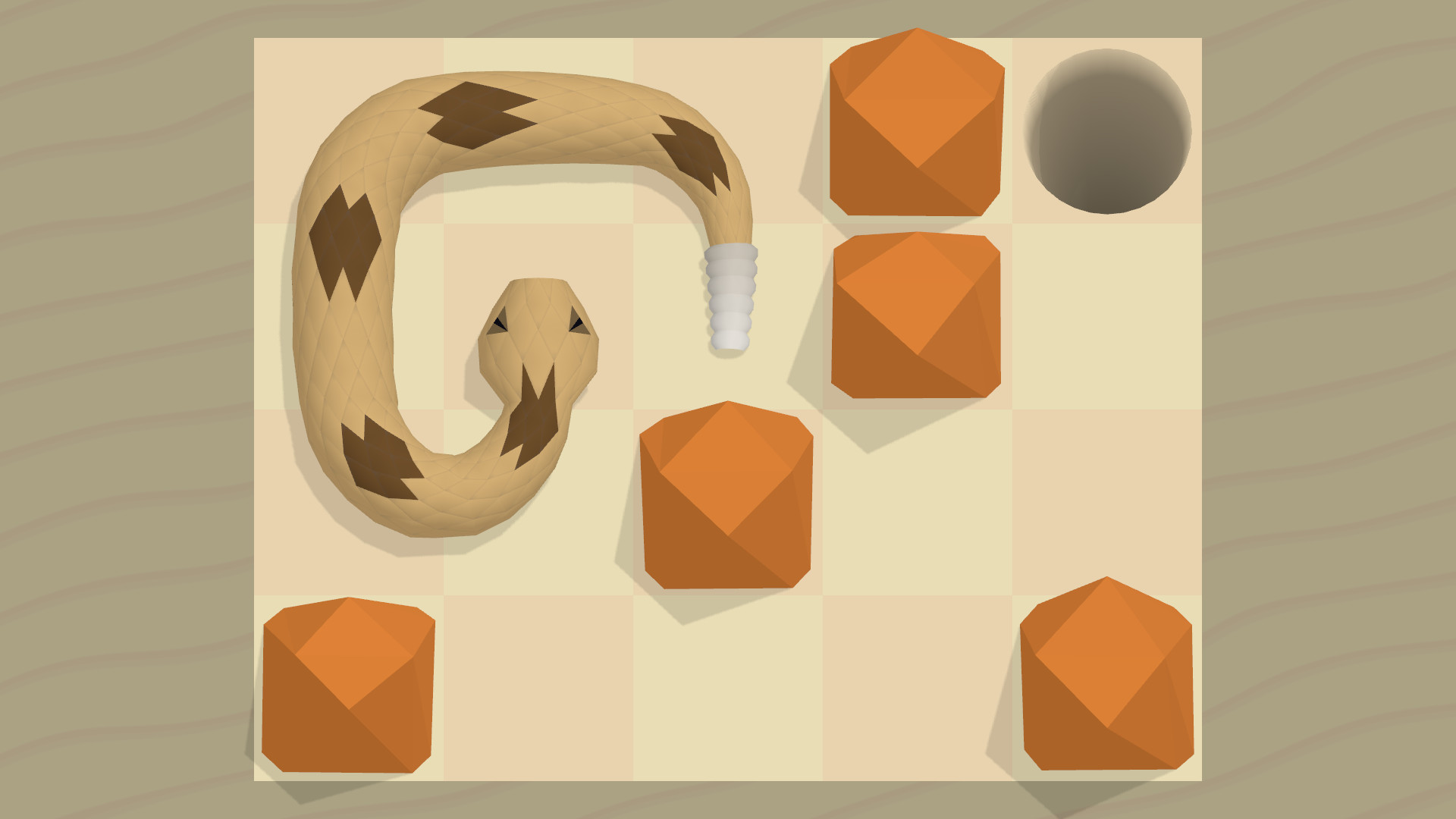
I spent some time thinking about what sorts of puzzles could be made with snakes on a grid, and something Rush Hour-like stuck out to me as a decent choice, so I started building out some levels for it and was pretty happy with the direction it was headed. I had also played Snakebird a year or so before (and loved it), and while I didn’t consciously think about it that early in the project, I’m sure it was a subconscious influence on me. (I ended up making Stealing from Birds a direct homage to Snakebird’s level 11).
-Michael
Vertebrae by Ali Nikkhah
A brilliant, difficult game where you are a little mouse that gets stuck inside a snake skeleton’s skull. Mechanically, the novel idea is that you can move backwards and attach vertebrae to your skeleton. The challenge of each level is figuring out how to place boxes on buttons, similar to the snakeoban games, but the backwards motion really adds a lot more complexity than you would first imagine. There are a remarkable number of original concepts explored throughout, with each level presenting a new idea. If you like hard puzzle games, this is one of the all-time best.
NB: Ali recently made a significant update to the puzzles in the game. If you played it prior to August 2019 I would recommend playing again from the start. (Latest news, there will be a 3rd edition coming out some time in the future.) Disclaimer - I helped a bit with the update. I also made some bonus puzzles you can find on my other post.
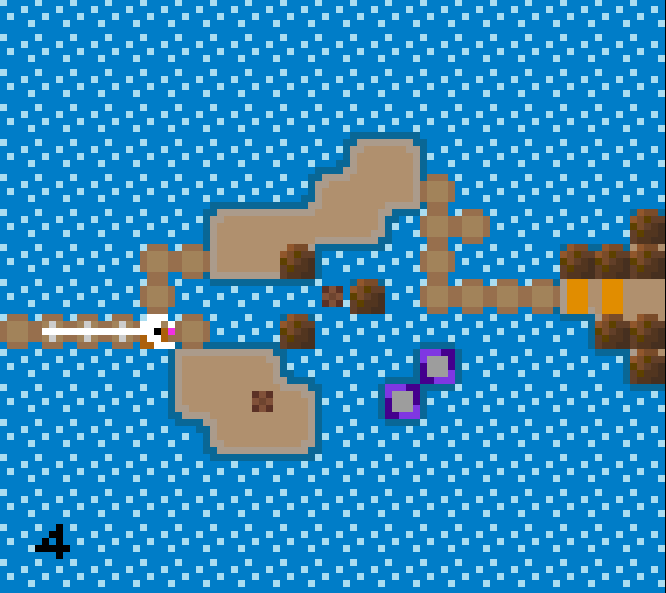
Okay, so this game’s mechanics is based on two what-if questions applied to snake mechanics; first “What if trying to move backwards did something?” and also “What if moving onto your body did something other than kill you?” The rest followed from there, with little adjustments being made here and there and other simple mechanics being added to enable making puzzles with the main mechanics.
-Ali
Train Snaking by Dario Zubović
A more snake-like variation of Cosmic Express. People who have played Cosmic Express will probably get the most fun out of this one, though there is nothing wrong with playing Train Snaking if you did not. It’s cute and the levels are short but interesting. If you haven’t played cosmic express and want a quick taste before looking at this game, the designer of Cosmic Express made a PuzzleScript prototype of the game called Train Braining, on whose code Train Snaking is based.
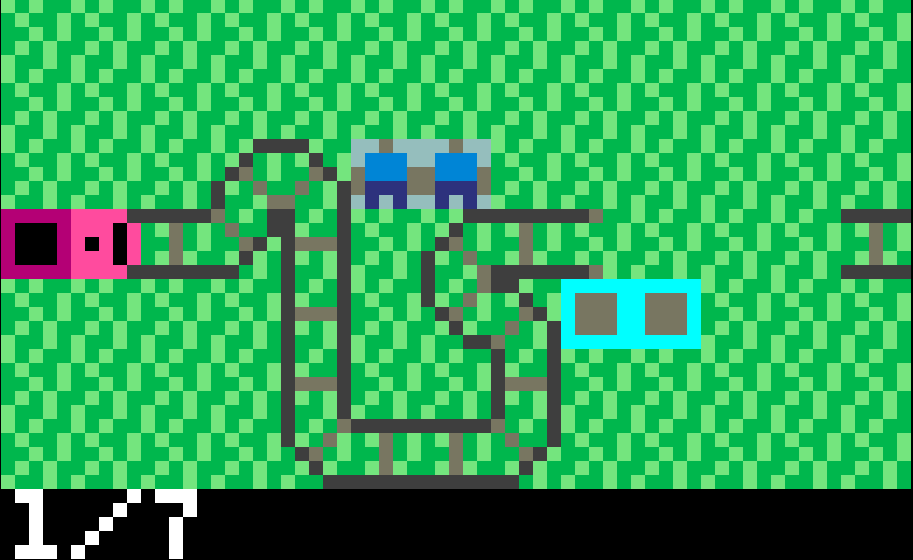
Puzzle Snake by Kroum Grigorov
An old (2006) game with basic rules: red dots make you grow, try to eat them all and reach the exit door. It has eight levels, and the puzzles work but are not that exciting. This is the second oldest game on the list, with Wriggle predating it by 3 years.
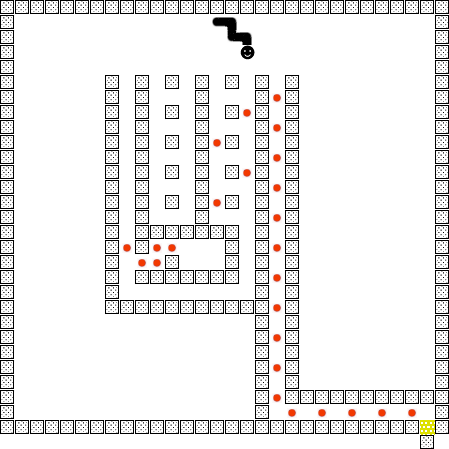
Snake Slider by Bas de Reuver
Snake Slider is a 2D snake game where you control both neutral snakes and a special green snake, and the goal is to get the green snake to the exit. The premise is similar to A Snake’s Tale above, and this ends up being much like a harder version of that game. Unlike most snake games, you can move snakes by either the head or tail in this game. The head is still slightly different in that you can eat apples from that side. This game is also similar to Wriggle (see below), with a few added mechanics, such as eating apples to grow, and pushing blocks. This is actually the first game to combine snake movement and block pushing, though the sokoban goal of getting blocks onto targets did not come until Wayne Myers’ Snakeoban in 2014. I believe Snake Slider and Wriggle were developed independently, though Snake Slider came out after the original Wriggle idea by Andrea Gilbert, which was in 2003. Both were inspired by Rush Hour.
Snake Slider uses a move counter, and a side goal is to find the optimal solution to each puzzle. This tends to be a divisive mechanic, as finding optimal moves generally puts more focus on brute-force logic than other types of puzzles do. However, I found the goal to work well in this game. All uninterrupted slitherings of a single snake are counted as one move, so efficient maneuvering is key. Finding the optimal solutions to the late puzzles gets to be quite hard. I think the game will still be interesting if you ignore finding shortest solutions, though the difficulty curve will become more variable. Works very well on mobile (both Android and iOS, as it’s run on mobile browser).
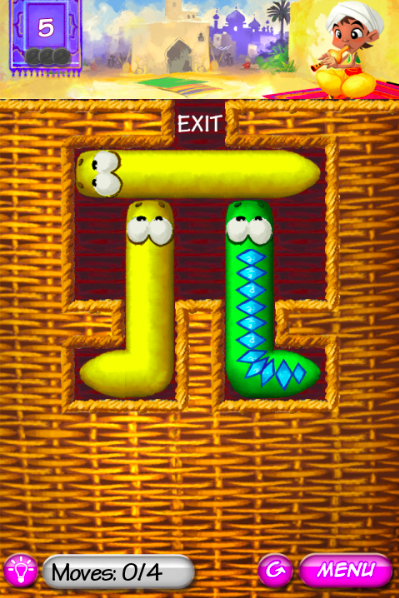
I initially created Snake Slider as a freeware Windows game in 2005. Direct inspiration was the Rush Hour puzzle game with the little plastic cars. I wanted to create a Rush Hour game except with trains that could bend, but quickly realised using snakes would be better. When the iPhone was released, I figured it was a good fit for the game because of the touch screen. I created 2 iPhone apps of this game in 2011, a free demo and paid version. Especially the free demo version was downloaded a lot, if I remember correctly at one point it was around 8000 downloads per month. Ultimately I had to pull the app from the App Store as it was making less money than the developer program annual fee. Again later in 2016 I ported the iPhone version as a Javascript webversion which was published by coolmath games. The best thing about the iPhone/web version is the really beautiful graphics, they were created by a professional company based only on some crude stick figure drawings I sent via mail.
-Bas de Reuver
Hungry Kraken by Stephen Lavelle
Hungry Kraken is ostensibly a kraken game, not a snake game. But its tentacles behave like snakes, and the game is quite fun. It comprises a single level, where you need to figure out how to use your tentacles/snakes in order to… well, you’ll see.
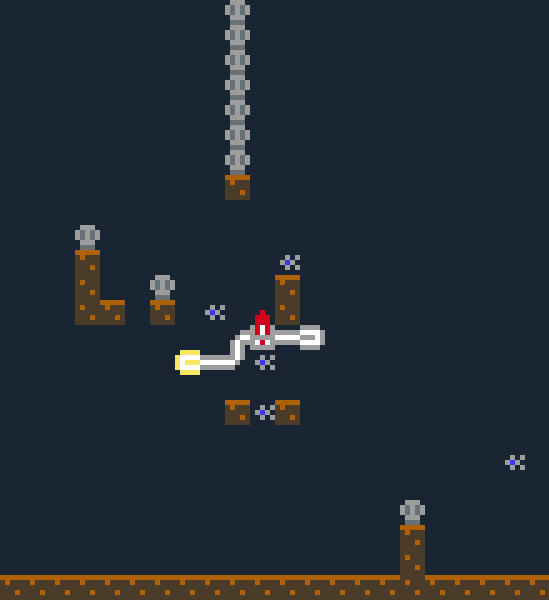
Shy Snake by Daniel Freer and Stephen Lavelle
Shy Snake has the familiar task of filling all the squares, but this ABSOLUTEUNIT has twice the width (and unimportantly 4 times the volume) of any other snake. With just 3 puzzles the game finishes quickly, which is necessary because that chonk has dinner reservations at the annual independent rodent art fair.
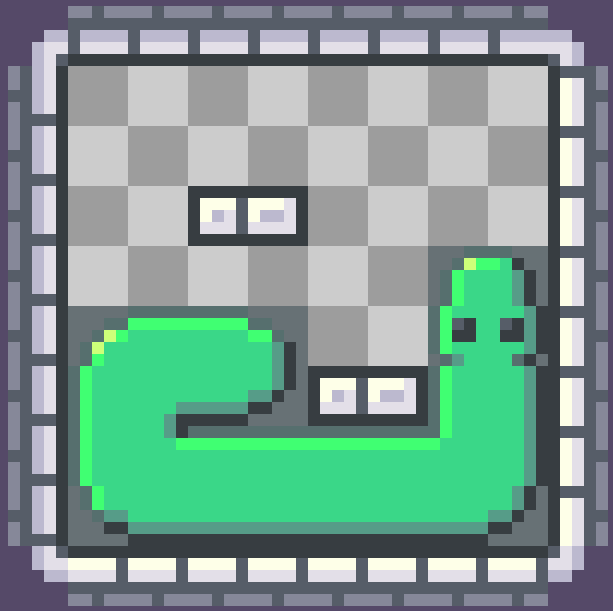
der Hydra Krypta by Stephen Lavelle
In “the Hydra Crypt,” when your snake head eats a human, the snake doesn’t grow longer - it grows another snake! The puzzling does require some trial-and-error because of how much is going on, but it’s very humorous and not too long.
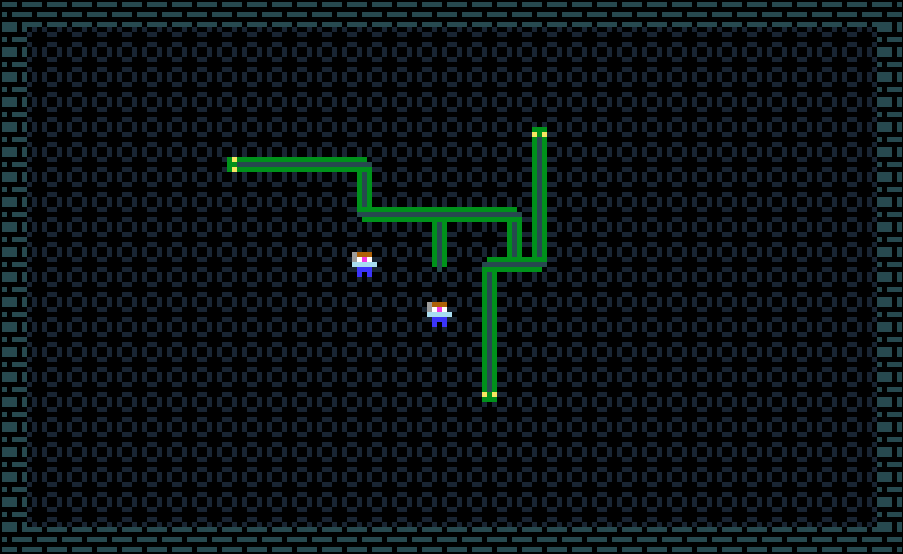
Wriggler Demake by Tapio Saarinen
Wriggler Demake is a PuzzleScript implementation of the original Wriggle mechanics: multiple snakes are on a grid and can be dragged from either end, and the goal is for all the colored tiles to have that color of snake on top of them (the creator of Wriggle later changed the goal to be an exit square, as in Wriggle 3D and TJ-Wriggle). All of the puzzles in this game are original and satisfyingly logical. One difference in gameplay is that the player controls movement using a pseudo-cursor, which has its own puzzle related consequences. The game is short and interesting, and will be worth looking at if you enjoy the type of puzzles in Wriggle or Snake Sliders.
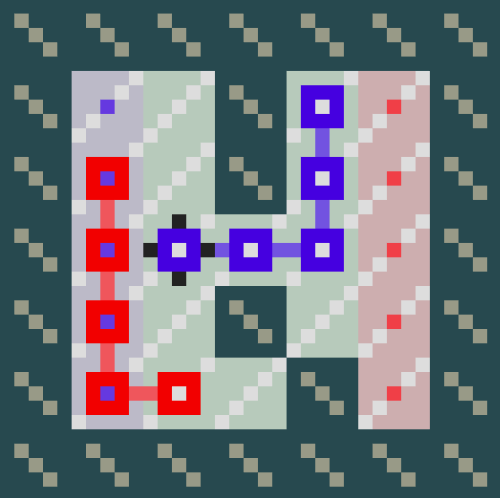
Wriggle 3D by Andrea Gilbert and Tom Jolly, developed by Conlan Rios
The original Wriggle puzzles by Andrea Gilbert from 2003 was the very first snake puzzle game, and Wriggle 3D is the most fully developed game in the Wriggle family. Wriggle was initially created as a variation of sliding block puzzles of the Rush Hour variety. In Rush Hour, vehicles can only move by their front and back, along the line defined by their long end. This variant relaxes the movement – the front and rear of the objects are the only parts that can lead, but instead of moving just in a straight line, they can move in any direction and the rest of the object will follow in a snake-like way. Wriggle 3D is the game I am writing about first because the original Wriggle puzzles had been unavailable until Oct 2020 due to java applets becoming defunct. I eventually got a chance to play through all the other Wriggle games and you can find them at the end of the article.
The extra flexibility in movement compared to Rush Hour is countered by blocking walls, to make puzzles that do feel quite a bit like Rush Hour, giving the same feeling of “how do I ever clear my path to the exit.” I think this is a step up, being more fun and deeper than Rush Hour. Deeper in the sense that for the same difficulty of puzzle, the solver will need to think more conceptually and strategically in this game. Like in Snake Sliders, the secondary goal is to solve each puzzle in the fewest moves (again counting a move as dragging one end of a snake by any distance). This proves to be quite a tough challenge, on par with Snake Sliders. There are many really interesting puzzles in the game, the final one being exceptionally nice.
Wriggle 3D comprises the same 80 puzzles that were present in a now defunct mobile app called Wriggle. They don’t overlap at all with the Wriggle puzzles currently on the clickmazes website. I find the graphics, music, and controls work well. It is only available for Mac right now.

Snortal by Stephen Lavelle
What would happen if you crossed Snake with Portal? That’s a question that nobody but Stephen asked themselves. It turns out to be a fun and difficult puzzle! I think it’s my favourite of Stephen’s short snake games.
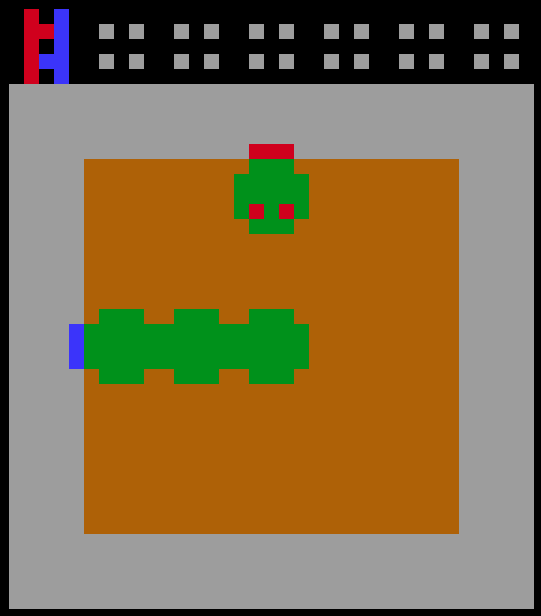
Snakey Snakey Makes a Sixy by Stephen Lavelle
What do you do in this game? Very mysterious… It has a snake, I’ll tell you that much.
I don’t think it’s as fun as Stephen’s other small snake games though.

SnakePace by LogicalCell
Another answer to the question “what if snakes could back up?” This one takes a little bit of time to understand how exactly the mechanic works. The goal in each level is to eat all the apples, and to do so you’re going to have to make full use of backing up. The levels are generally pretty interesting.
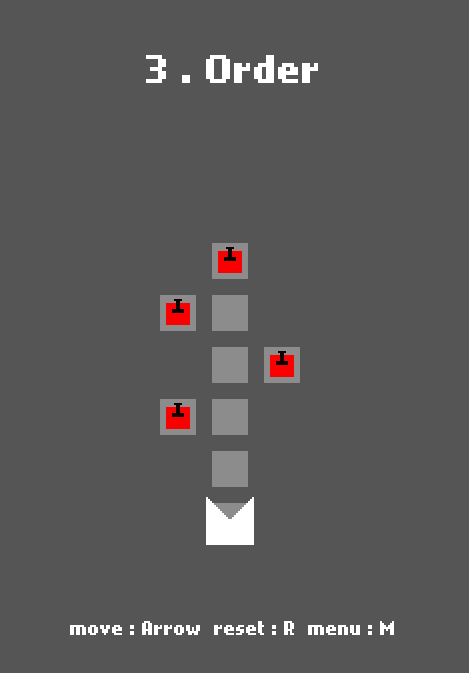
FillerSnake by Jaberish
A Hamiltonian Path style puzzle game, similar to Shy Snake above, where you try to visit each square in the grid once with your snake. There are a few twists, including locks and keys, bombs, and more, which add some fun to a sometimes mundane genre. The puzzles are generally good, though some of them are further towards the trial-and-error side of things than I would like. Lacks an undo button, which you may find objectionable. Although there are a lot of puzzle games of this type, not all of which I really consider snake games, this one was interesting and snake themed, so I have included it. See the excluded games discussion below for a number of similar puzzle games that did not make it to the main list.
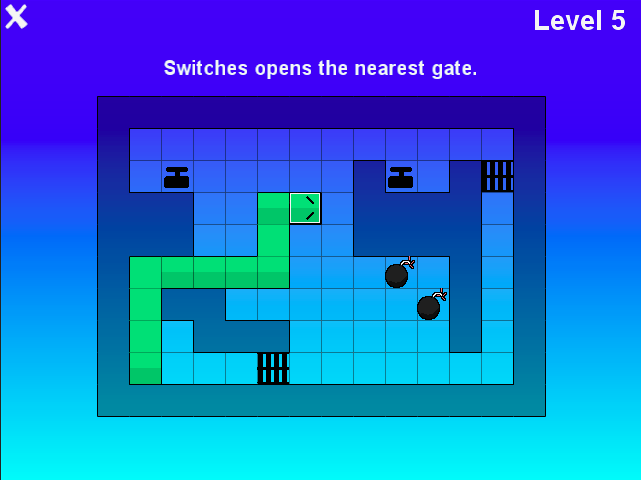
I wanted a game that had less of a repeating arcade feel and more of a puzzle feel. Mostly because I wanted to put more of my creativity in making puzzles itself. This game was inspired by other games with similar game-play but built upon by adding new concepts (mostly through the tile interactions). I believe most players like playing games that have “life” in it, so I made the main tile be a character with eyes. Using a snake character felt the most appropriate given the game-play.
-John H
SnakekanS by Wu Binxing
SnakekanS is a fantastic iOS game that starts with the basic snake idea, where you need to eat all the animals and then reach the exit, and adds different animals that have special mechanics. The first special animal you encounter is the frog, which changes the direction of your snake when you eat it. What a simple idea with such great potential! I found the other animals also interesting, though none change the game quite as much as frogs. I won’t spoil their mechanics here but you can read about them in the designer’s note below. The level design is very well done throughout, and the final puzzle is particularly memorable. Before getting comfortable with all the mechanics it can feel like some puzzles are too open-ended, having not enough direction and resulting in a lot of trial-and-error, but with time you gain the ability to spot the central ideas in each puzzle better, and are able to think through the level without as much testing. Graphics and sound are very pleasant, and controls work well. Overall it gets a high recommendation from me for its innovation and puzzle design.
Wu Binxing sent me a wonderful little essay about the game, which a friend translated:
I played Snakebird after I decide to create a snake puzzle game. The mechanic of gravity make the game very intersting. So I try to find a core mechanic about my game. My first idea is reverse. Then I try to make a level of reverse.
After we decided on the key mechanism, we first added the fundamental element, which make the snake grow one grid after it eats. This is something common to all snake games - I call it 'rat/mouse'. Now, we consider what the next element would be.
First of all, to maintain its simplicity, I dont think the game should have any 'ground' element, as different maps would already have achieved that. As we choose to have a wide selection of food for the snake, we should keep the other elements simple.
Next, we realize during the design that there will be multiple ways to pass a level, and one of that might be too simple. Hence, we need a way to tweak the design and create something like an 'obstacle'. That's how the Mantis is created. There is an old Chinese story called 'Mantis captured the Snake'. It's about a Mr. Zhang who saw a mantis hold the head of a snake tightly, ripped open its skin, and eventually killed the snake. The effect of Mantis is simple, it faces one direction, and if a snake passes a mantis, snake will be killed. Now we can change some of the rat into mantis to make the game more difficult. Later on, we notice that it also goes the other way around - having the rat transform into a mantis reduces the number of obstacles a player has to consider, and eventually makes the level easier. Therefore, having the Mantis element helps us adjust the level of difficulty.
We eventually decided on the 'Shadow play' art style. Shadow play is a Chinese folk drama art - it's similar to puppetry. The puppet used in Shadow Play is made with translucent leather, with color painted on them. Light is shone from behind the screen, and the drama is carried out with the shadow of those puppets. Shadow Play style is designed concurrently with the creation of new elements. We deiceded to employ more Chinese elements in the design, and started considering the elements often associated with snakes in the Chinese tradition.
The first animal we considered was Elephant. There's a proverb that pretty much goes like this: "A man whose heart is not content is like a snake which tries to swallow an elephant." How do we design a mechanism with elephant? We came up with the solution that after the snake eats an elephant, it will grow longer after each step. This design and its reversal work quite well together. Player can use the reversal ability to transform the snake's tail into its head after it eats an elephant, then the snake would reach the exit. On the other hand, you can use the elephant independently, or the player can choose when to eat the elephant. We tried that with a few levels, and realized that by strategic placement, we can break the intuition that 'the later to eat the elephant, the better'. In levels where there exist elephants, most of them are not eaten the last - there is even one level where player need to eat the elephant first.
The second animal is the Turtle. The making of turtle is a more complicated process. At the time we have adopted the Shadow play style, and we tried to emphasize the key element of the game (reversal) by changing the color of the snake between Green and Orange. With this mechanism in place, we came up with animals only the green snakes can eat, and those only orange snakes can eat. However, we didnt move forward with this design. The problem with this design is that players do not come up with new ways of thinking. Instead, what if the turtle retreated into its shell in advance of the snake attacking, then snake wouldnt be able to digest the turtle in this form, and turtle would stay inside of the snake's stomach for a long time. Then snake would not be able to eat other food, and eventually would die from starvation. Based on this design, we came up with the turtle mechanism. When the head of the snake approaches a turtle, the turtle retreats. After the snake swallows the turtle, it will continue moving, but the turtle would stay stationary. If the snake continues moving, as soon as the turtle moves to the tail of the snake, snake dies.
We realize then that adding the turtle creates new ways of thinking/problem solving. In levels where there are many turtles, and if exit would only open after snake eats all animals, we wonder what the shortest distance would be if snake has to eat all turtles. We would know how long the snake grows eventually by counting the number of animals in each level. We then look for the shortest routes by considering the eventual length of the snake. For many levels, the length of the shortest route is the same as the length of the snake. This helps players to come up with a new way of thinking when they are in the middle of the game. Players who discovered this would be able to pass levels faster and get to enjoy the game more. Not all elements work this way, and we would use this as a way to measure the quality of an element when we design new games in the future.
Currently the game mechanism has no correlation with the Shadow play; if it wasnt Shadow play style, it can be something else and the game would still work. Eventually, we think if the snake is a puppet in the Shadow play, it should be able to break into parts. However as the snake can only move up/down/left/right, and the mechanism to break the snake is too complicated, we decided to make the snake broken into parts at the beginning. When the broken parts get close to each other, the snake would reconnect its parts. Broken snake and reversal mechanism also work really well. Reversal would allow player to switch between two parts. As reversal means different things with reconnecting and breaking different parts, the timing to reconnect becomes very important. There exists a sequencing issue too as the broken snake cannot reconnect after it eats the elephant. There is also a level where the player needs to reconnect the parts at the last step to prevent the snake gets killed by eating a turtle.
That's all. Thank you for reading.
-Wu Binxing
Quetzalcoatl by 1button sarl
Quetzalcoatl is an iOS game that draws on the original Wriggle mechanics, where you want colored snakes to lie on specific tiles according to their color. Quetzalcoatl makes the win condition more flexible by allowing colors to be applied to specific segments of snakes rather than entire snakes. The game has 180 levels, that I feel is somewhat influenced by a push for quantity in iOS games in general. I think the game would have been more enjoyable for me if the number of levels was cut down, but some may like that you can use similar techniques on increasingly difficult problems, honing your skill. The puzzles are grouped by difficulty, including easy, medium, hard, and ultimate. The last set of puzzles is indeed challenging, sometimes requiring insightful solutions and sometimes requiring good old hard work. There is generally quite a bit of variety in the style of puzzles. Some are claustrophobic “how do I swap these snakes in such a tight space” puzzles, while others are expansive levels where an appreciation of the overall geometry is key. The touch controls work extremely well, and the art is nicely colorful.
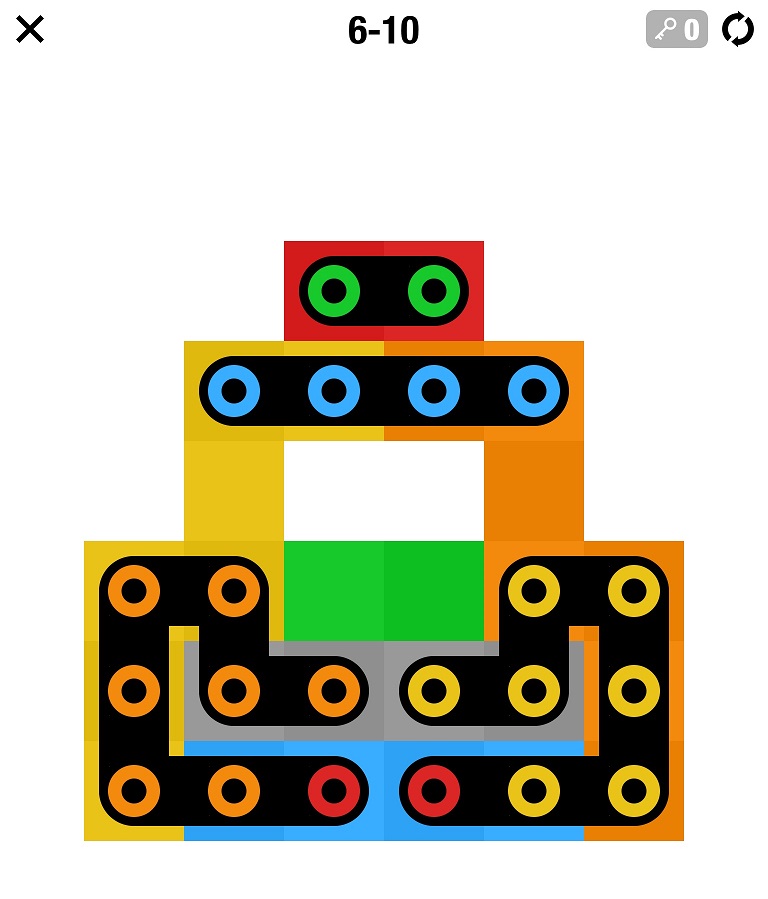
When we started to work on this game in 2014 we wanted to create a puzzle with snakes and colours. With this idea in mind, everything came very easily to us: a grid with coloured tiles, snakes with coloured dots, drag the snakes to match the colours. We made a quick and dirty prototype in about one hour just to validate the principle. We realised that it has a huge potential for many different levels. Then we developed a level editor (a private iOS app) and we started to work on the puzzles (everything is handmade). At the same time, we also worked on the game itself, designing the graphics and the sound effects. The minimalist graphics kind of reminded us of aztec symbols, so we wanted to name the game Quetzalcoatl (the feathered Serpent in Aztec mythology). We hesitated a lot because this word is very difficult to spell, but we didn’t find a better name and we got used to it.
-Jérémie
Snake Blocks by Spooky Cat
Snake Blocks is a game about connecting pairs of colored points in 3D space, where one point is the start of that color of snake and the other point is its destination. This is like a 3D version of the familiar 2D pen and paper puzzle – connect pairs of points using lines without crossing. The 3D snakes can support themselves in the air (as long as any part of it is touching the ground), meaning that the order in which you draw out the snakes doesn’t matter. I think it might have been more interesting if it worked similar to Lime Rick, where every segment of a snake needs to be supported against gravity. There is an added constraint that each snake can only grow to a certain maximum length. It can be a bit tough to get the snakes to go exactly where you want them to using the cursor controls, but I didn’t find it too annoying. The puzzles provide a good exercise in thinking in three dimensions, and can be fun but at times also have a bit too much trial-and-error.
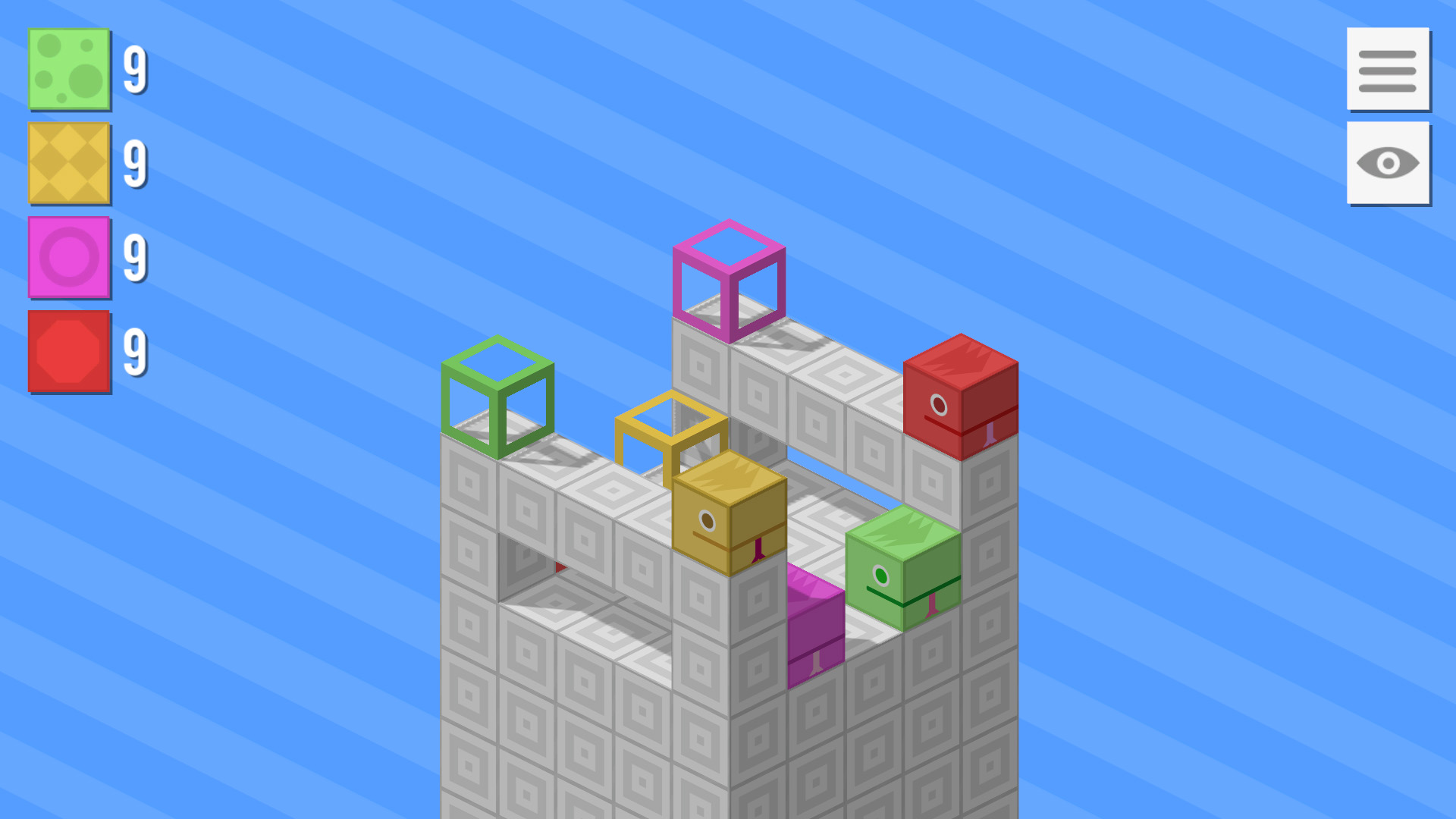
SNIKS by Shelly Alon
In SNIKS, like in Quetzalcaotl, the goal is to have each colored square (here represented by colored fruit that you temporarily ‘eat’) be matched by that color of snake on top of it. The big twist in this game is that snake segments (but not heads) of different snakes can overlap, which makes it feel quite fresh. There are additional mechanics common to many snake games, like teleporters and things that make you grow in length. There is also a mechanic in world 4 that will be familiar to players of other types of puzzle games, but which has never been done in a snake game before (okay I’ll spoil it, it’s ice/sliding movement). It works surprisingly well! The music and graphics are nice, but the controls feel a little slow at times. The puzzles in SNIKS focus equally on determining the end-state of the puzzle and on maneuvering to get there, while in Quetzalcoatl the focus is more on the maneuvering. This game also distinguishes itself in having a large variety of mechanics to play with, whereas the variety in Quetzalcoatl comes more from its different puzzle geometries.
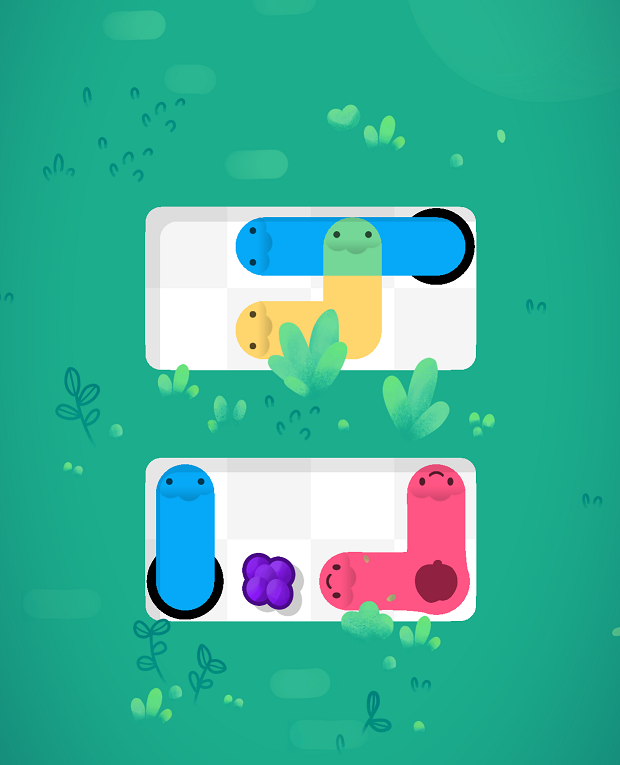
Snake Sokoban Spiral by Justas Dabrila
Snake Sokoban Spiral is similar to Tail of the Serpent in that the goal is to match snake segments to symbols on the ground. One idea added in this game is that segments get stuck to their ground markers for 1 turn, which allows for rearranging segments but can also make things trickier. The next addition is the “roll” move, which works somewhat how you’d expect it to and definitely shakes things up. A short game with new ideas, interesting levels, and also some rough edges.
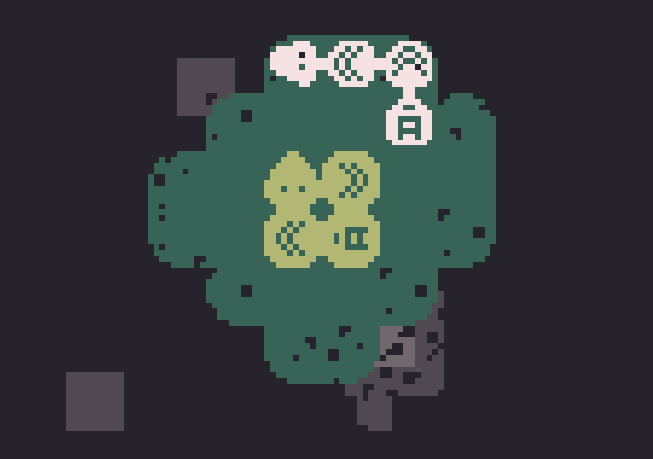
Around the time of development I was frequently deconstructing various puzzle games and taking note of the individual actors, their states and the rules between them. It was fun to paper prototype games with a small amount of actors that maximize the state they can be in.
LD45 was starting. It was around 1 in the morning. The theme was “Start With Nothing” and nothing exciting came to mind for a few hours. I recalled seeing a game by Lucas Le Slo titled “The Tail of the Serpent” on a stream a while ago. Feeling defeated, I attempted to sleep on the idea of making a snake game. It wasn’t long before I started thinking of a design that had more actor states than actors.
Instead of sleeping, I booted up my editor and messed up my sleep for the rest of the jam. I think it very clearly shows: Some of the levels have unintended solutions. The difficulty curve at the very start has a very unwelcome spike. I even neglected to think that the snake pieces should mirror their direction after being rolled!
For the 48 hours it took me, I was happy with the game when I had called it done. Now having all this behind me, I can’t help but be reminded of Chris Hecker’s “Please Finish Your Game” rant from GDC 2010.
-Justas Dabrila
ENIGMASH by Jack Lance
ENIGMASH is the Frankenstein’s Monster of puzzle games. Patching together different puzzle themes within individual puzzles, and then connecting those puzzles together in a single world, it’s a marvel of PuzzleScript code and puzzle design. Whether Snakes appear in it is unknown. Perhaps I am including a game without snakes so that the next time I add a game with surprise snakes to my snake article, nobody will see it coming.
If the suspense is imprisoning you with uncertainty, turning you in a shadow of your former self with bags under your eyes and under your ears, waiting out the days until you are not alive enough to care about serpentine lore, if you find yourself in such unconscionable circumstances I suggest this remedy: you must enter a parallel universe where intelligent snakes play games about insentient humans, and determine whether their ENIGMASH features humans. Though a redoubtable task, it will be aided by consultation with the eminent snake authority on human puzzle games†. You might protest - “but such a universe cannot exist, an intelligent snake studying frivolous human puzzle games is a contradiction!” Actually you’re right, I hadn’t thought of that. Still, we can surmise that if humans did appear in TRANSUNIVERSALENIGMASH, they would probably have the ability to decompose into their component blocks, which can then be rearranged and recombined.
†Liability waiver: by reading this article you agree to take all responsibility for the risks associated with interdimensional research including but not limited to being directed in an infinite loop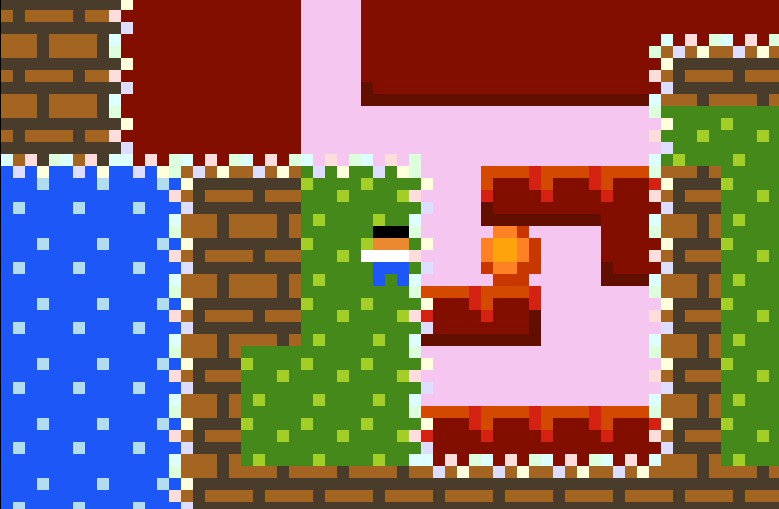
Snakey Jakey by Ethan Clark
Snakey Jakey is a snake that doesn’t like to follow the rules of physics. In Snakebird you can defy physics by pushing snake A with snake B, even if snake B requires snake A’s body to push off of. Jakey takes this a step further by being able to push himself. There are a couple of other new things expanding on that idea that you’ll discover in later chapters of this PuzzleScript game. The movement feels strange initially, but you get the hang of it quickly and the experience is interesting.
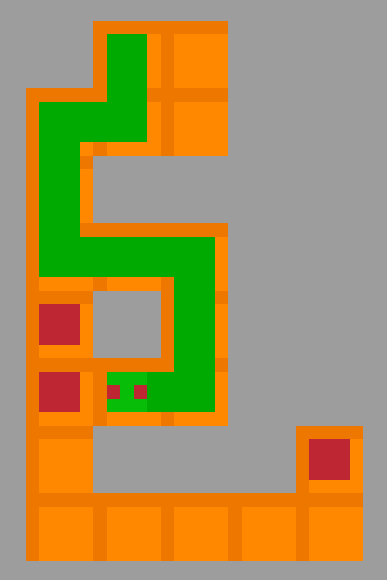
This game started out as a way to take a break from my current big project. I’ve played my fair share of snake puzzle games, including many of the games on this article. For this game, I conceptualized a snake game where the snake could push itself.
In the original prototype, the snake sort of pivoted its tail when it pushed itself. This was really unintuitive, and extremely difficult to program. So, I changed the rules to make pushing yourself be a lot simpler, and it immediately became much more intuitive, was easier to program, and had a lot more puzzle potential. After that, it was pretty easy to make the rest of the game!
I’m happy with how this game turned out. If I ever need a big project that isn’t too big, then it might be nice to remake this game into a full-fledged browser game. Of course, I’ve learned that I shouldn’t make promises when it comes to sequels, but it’s definitely a possibility!
-Ethan Clark
Bottom Feeder by Zach Abel
Bottom Feeder is a wonderful PuzzleScript game that explores an innocuous sounding twist on snakeoban: you move around like normal with your head, but can only eat from your tail. The way this works is when your tail comes into contact with a food pellet, it will gobble it up and move a space in that direction. The implications of this rule are quite interesting and are explored in the first few levels, while the later levels provide masterfully crafted snake challenges.
It is unfortunate that snakes hold a reputation of being scary, menacing creatures that evolved to ambush, strangle, and poison their unsuspecting prey. I can assure you, however, that you will find the present breed of snakes who grow rapidly by devouring up their anus to be delightfully cute.
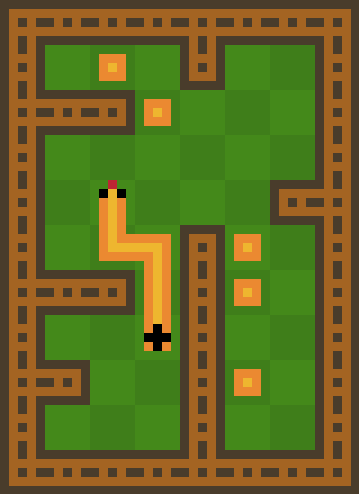
As an excuse to experiment with Puzzlescript, I set out to make a short, narrowly focused game by adding a tiny spin on an otherwise familiar mechanic. A few rejected snakey prototypes later, and Bottom Feeder started taking shape! My first three level ideas (which eventually became 1/9, 3/9, and 7/9) all related to some form of pellet avoidance, so targets arose naturally to balance an otherwise one-sided “eat all the things!” feel.
In retrospect, the way snakes reform front-to-back in Jack Lance’s ENIGMASH partly inspired Bottom Feeder’s “eat from your tail” mechanic. [Editor’s note: although it may seem to, this does not imply that ENIGMASH has snakes]
Stylistically inspired by Jack Kutilek’s Snakehole, I experimented with levels that explored their key idea from multiple perspectives and/or with multiple “aha”s, instead of always splitting individual insights into separate levels. And some of the puzzles are better for it! For example, Level 6/9 benefits from breadth (no spoilers!): it features several loosely-dependent challenges that all relate to the same central premise, instead of needing to laboriously duplicate the basic setup multiple times. Level 8/9 explores depth: a single task that gets revisited multiple times as successive layers of nuance reveal themselves. Both seem to provide a clear sense of progress, so I like how they turned out!
Unfortunately, Level 1/9 doesn’t seem to offer that same assurance of partial progress. And especially given its early placement, it would benefit by being split into (or at least prefaced by) a more welcoming, multi-level intro sequence. I hope to revisit this eventually!
-Zach Abel
Puddle Knights by Lockpickle
Riddle me this: what creature slithers like a snake in the morning, walks upright at noon, and when put in a barrel makes the barrel heavier? The answer of course is the unlikely Puddle Knight, whose cape trails behind him, snaking along the ground so that a bishop or lady may reach their exit unbesmirched. Aside from inspiring gratitude for modern-day drainage systems, this game brings to us an excellent puzzle solving experience.
A similar idea was toyed with by Steven Miller in his Snake Trail (see entry above), but the key design idea that pushes this game to great heights is having all characters share the same open space, and dividing the snake character into a head (knight) that collides and a tail (cape) that does not. A neat mechanic that is introduced near the start is that you can tear off cape segments so that they permanently cover a patch of mud, adding a resource management element to the already rich snake ideas. With several more interesting twists along the way and good humour throughout, Puddle Knights makes for a great game to be enjoyed by a wide audience. I would place it just behind Snakebird as my second highest recommendation to newer puzzle explorers. ElectronDance has written something about the game as well.
In July 2020 a new chapter was added to the end of the game. It has a slightly new mechanic, but mostly contains a few more challenging puzzles. In October 2020 another chapter was added with a new lava-related mechanic. Both additions are worth playing if you missed them initially.

The theme of Ludum Dare 43 was “Sacrifices must be made”. It was Olli Etuaho and Antti Hamara around the table, and we wrote a sheet full of whatever ideas and concepts came to mind from the theme as usual. One of them seemed to stand out: the cliches of chivalry and how knights would drag their capes through mud to let noble people pass through unsoiled. It seemed funny and was soon combined with snake-like mechanics. We had no idea where it would take us at that time.
The prototype did OK in Ludum Dare but not great: We had no animations at all, the 3D graphics were extremely basic and generally everything was a bit rushed, so no polish to speak of. But it already had a handful of decent levels and cape tearing mechanics too, which is one of the more unique things about the game. Valtteri Heinonen had made some very medieval sounding music that created an odd ambiance in the prototype.
Something about the concept stuck, so when it came time to find the first project for Lockpickle with Harri Dammert this eventually settled on this one. We liked that the game had fun characters and also gameplay and theme joined at the hip as opposed to some more abstract puzzle game prototypes we had at the time. We were still a bit nervous about how far the mechanics would scale, so we spent early months of the project just building out additional mechanics - which now seems like a mistake from a marketing perspective, but we ended up with fairly solid gameplay early on.
From there on it was just iteration. On the design front we kept firing on all cylinders: in addition to Harri and Olli we had Pyry Takkunen working part-time on level designs so we had a variety of ideas, and got feedback from indie heavyweights like Arvi Teikari, Petri Purho, Elyot Grant and Olli Harjola. We think it shows in the final product.
-Olli Etuaho
Snaliens by João Ferreira
If snakes were also aliens, would you call them Snaliens? The problem with that is it will get confused with snails + aliens. To the best of my knowledge this is the reason snakes have not ventured outside the earth’s atmosphere. But in a videogame, anything goes!
Snaliens is only about a third snake puzzles, but that still amounts to a good selection. In this game, the aliens you control can pick up pieces that follow them around like snake tails, and these pieces have functions such as holding buttons down, or connecting switches to power. Like in Snake Sokoban Spiral, it is important to have your segments in the proper orientation as well as location. The game combines a large number of different mechanics that on their own feel familiar, but combined with snake movement make for unique feeling puzzles.
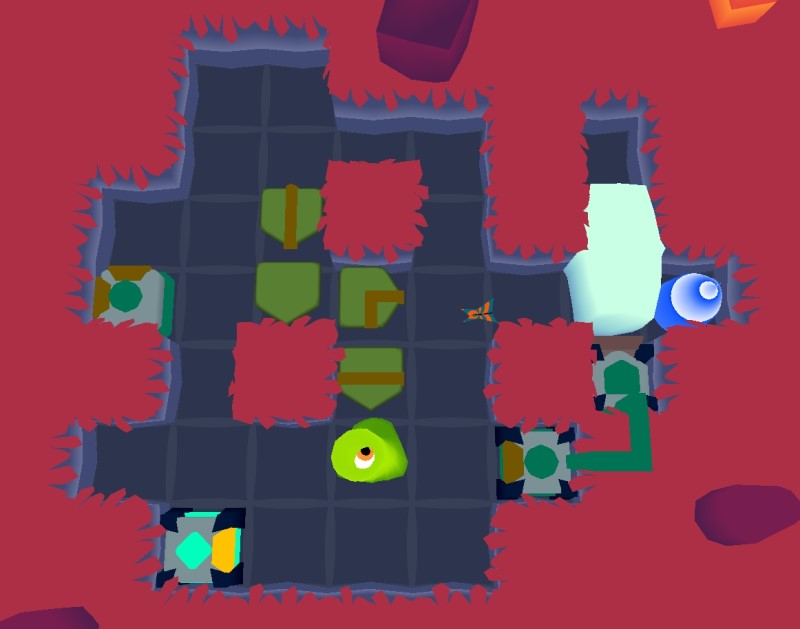
Snaliens is the outcome of experiments and ideas over its development time. The original idea came way before the development phase. The plan was to create a casual snake game where the body parts influence each other. However, as the implementation of these ideas began, the emergent relationships between the different mechanics seemed to be a good fit for a puzzle game. From that point and with a prototype ready to play around, it was a matter of iterating through different ideas to find what worked in favor of the game.
-João Ferreira
The Turing Snake by edmond00
The Turing Snake is a very clever mix of snake game and programming. Puzzles are set on a grid of 0’s and 1’s, with each segment of your snake performing a different action depending on whether its cell is on or off. By placing a limited number of 1’s on the grid you must guide your snake to the goal. This game was made for a game jam in which the theme was “only one.” Many of the puzzles require you to place just a single 1 on the grid, which ends up working nicely. It’s an interesting game, and quite impressive for being made in a short time. With 20 levels it doesn’t feel lacking for content, but with such a great premise I hope it could be expanded in the future.
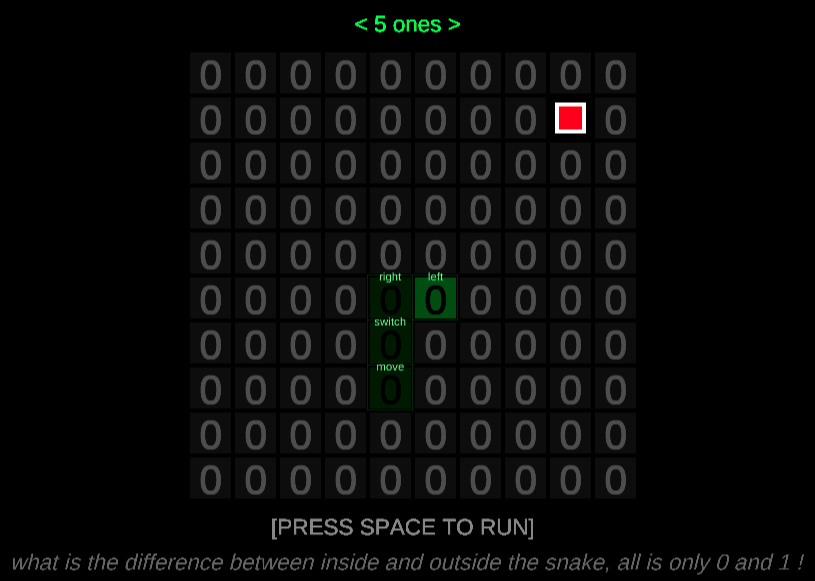
My first inspiration for this game was the cellular automaton like the game of life of conway.
It is something that I was interested in and I thought it could fit the ‘only one’ theme of the jam I was participating just by replacing the classic black and white grid with a 0 and 1 grid. Combining this with a snake game was a way to also have reliable game mechanics (eat to grow, don’t eat yourself, …) that the players will immediately understand.
Looking for an idea for having both, I found that using the snake as a list of commands could be nice because it can quickly produce a lot of interesting complexity (where you move affects what actions you will execute that affect where you will move…).
I usually prefer making sandbox games but here it seems to me that having some puzzle levels was the best way to introduce the ideas of the game (but I still added a sandbox mode at the end).
To make the puzzles, I just tried randomly different configurations and chose the one where the snake ends up in a place that will look unexpected for the players while gradually adding new mechanics.
The Turing machine was not my first inspiration but it ends up looking a little like a 2D Turing machine so I chose this name.
-edmond
Tile Snake by Andrew Tollett
Made for Ludum Dare 35 which had the theme “shapeshift,” Tile Snake lets you fill holes in the floor by dropping segments of your body there. Don’t worry, you can pick them back up later! It’s a nice idea that adds a few new maneuvering techniques to the standard snake repertoire. Also included are doors that require a certain number of segments to pass, optional goals, and a few other familiar mechanics. It is relatively short and easy, but fun anyhow.
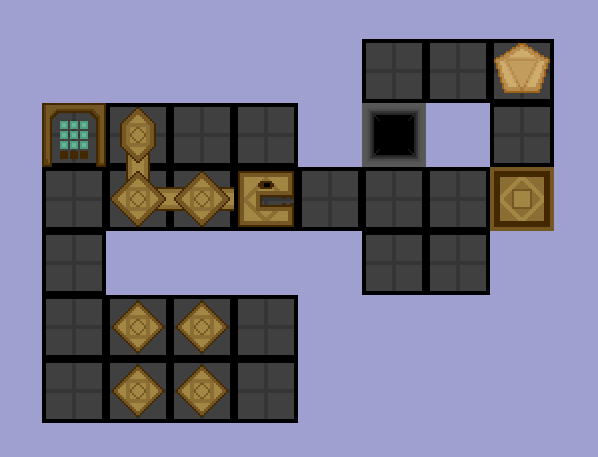
Shackle by Steven Miller
In Shackle you resemble a length-3 snake, but instead of having a head, body, and tail, you are a prisoner shackled to a ball & chain. Dragging the ball around behind you feels perfectly snake-like, but you are also able to walk over your chain (snake midsection) and push the ball (snake tail), a humanoid subterfuge! The goal in each level is to reach the exit, and doing so will require activating colored sensors to raise or lower walls - a familiar idea in non-snake puzzle games. Its combination with the novel ball & chain movement works exceptionally well, revealing both fun ideas and marvelous puzzles. It begins gently and the difficulty curve is gradual, but it ends with some devious head-scratchers, the last of which is one of my favorite puzzles of the year.
You might have recognized that the game is actually a trenchant metaphor, the prisoner being me and the shackle representing this article with its need for continual updates. Steven completely nailed the dreary atmosphere and the prisoner’s pale complexion.
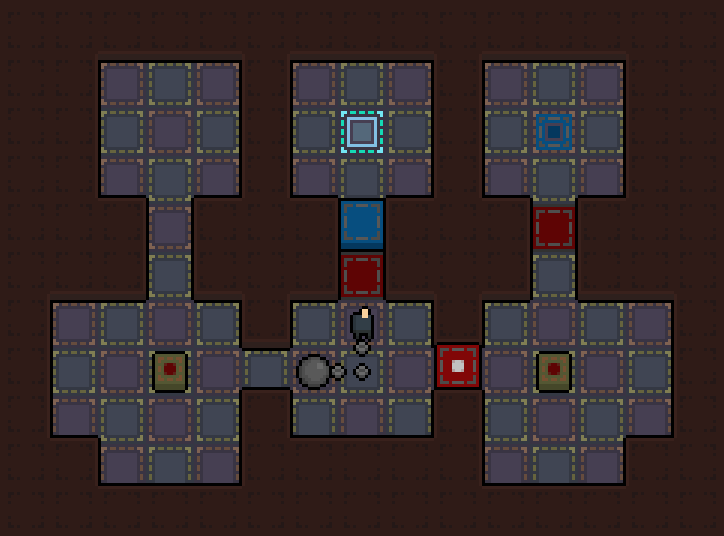
Shackle was an idea I came up with after going through the Snake Puzzle Games article for the first time. The original concept was for a snake game where you could step over your tail and, with some clever positioning, push boxes around with it. The chain was going to vary in length from puzzle to puzzle, allowing for slightly different maneuvers in each one. In the end, the unintuitiveness of the chain movements led to that component being scrapped, but the same core idea remained: a snake-inspired sokoban where the tail acts as both an obstacle and an essential tool.
-Steven
Crocodiles Love Cookies by Ethan Clark
Crocodiles Love Cookies, though probably apocryphal, is a game that feels like a mix between Lime Rick, where you push boxes into place while fighting gravity, and Hungry Kraken, where snake-like tentacles are controlled to bring food to the kraken’s mouth. A short and light-hearted game with the most crude of PuzzleScript graphics, it’s still impressive that it was completed in only (see below)

I made this game in like an hour or so. It was inspired by a GIF of a prototype Joseph Mansfield tweeted out.
-Ethan
Monty’s Way Home by Alex Cline
A short retro style snake game where you eat pellets that either grow or shrink you, and the goal is to fit inside a target area. It’s pretty basic, but one little novelty is that you do not need to eat all the pellets to complete a level, but instead must decide which ones will work.
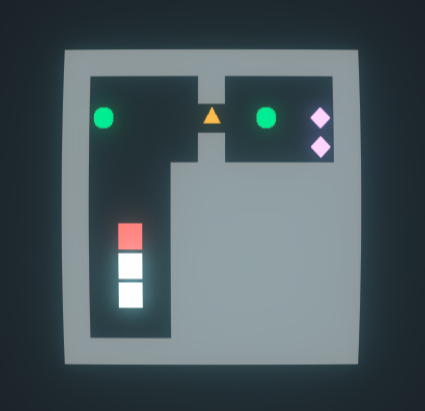
Snakes without Brakes by Kodub
Snakes without Brakes is a hybrid of the eat to grow snake mechanic and ice (sliding) movement. While SNIKS was the first (and only prior) snake game to incorporate sliding, this game uses it to different effect. Here the snakes grow quite a bit longer, there is a much larger level size, and the goal in this game is just to eat all the pellets. Solving these puzzles involves a lot of working backwards to see how a pellet can be reached via a sequence of ricochets. A few extra mechanics are added amongst the 20 levels, a couple of which are fairly specific to the sliding mechanic, so they also add to the game’s character. Graphics are minimalist, which I guess makes sense as the game was submitted to LOWREZJAM 2020.
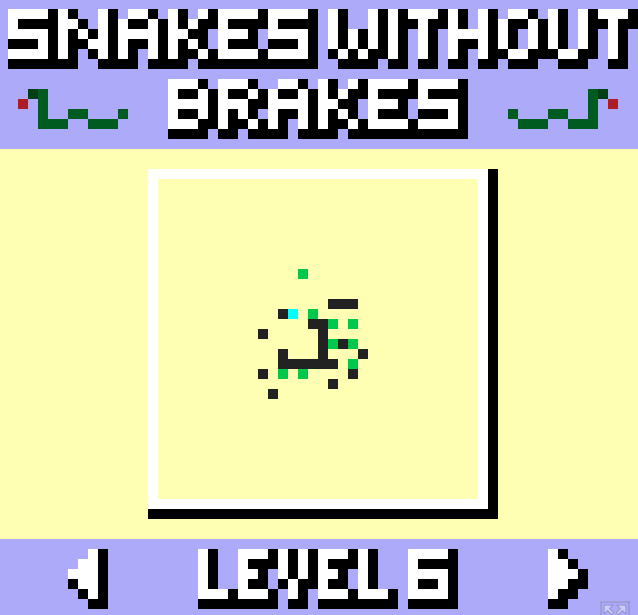
Worm Jazz by Inconspicuous Creations
Worm Jazz is an exquisitely produced game that has unique and interesting mechanics. The first idea is the green pellet, which when eaten stays in your body at the position you ate it, and when you would otherwise die you instead regenerate a head at that location. You won’t be dying to nefarious worm-haters, but instead you’ll be walking over mines in order to clear them. The next special pellet is the bomb, which also stays in your body and will explode when that part of you is destroyed. In concert, these abilities let you sacrifice parts of yourself to strategically open up space on the map. There are a couple of other mechanics introduced later that synergize well with the core gameplay. Actually I liked the last area so much that I wished it was mixed in earlier, but I won’t spoil what happens.
The puzzles in Worm Jazz are of a good quality, and in each you can score 1-3 stars depending on how many of the pellets you were able to eat. I think this was a pretty reasonable way to add flexibility to the difficulty. One drawback is that it’s hard to make a perfectly smooth difficulty curve without knowing how many stars the player will be going for, but it felt fairly good going for all the stars. A small criticism is that I felt most of the puzzles had high depth and low breadth, which is not generally my preference. By this I mean that you are often constrained to a few main options, each of which sets you down a path with several consequences. Because of this, it can be harder to plan ahead without doing some experimentation first. I suspect the developer found that having more open puzzles would give the player too much power. That said, there are more than enough puzzles here with satisfying logical challenges.
Concluding with more words about the production: the original jazz music is very good, graphics are excellent (though effects could have been more subdued), and you can unlock funny hats!
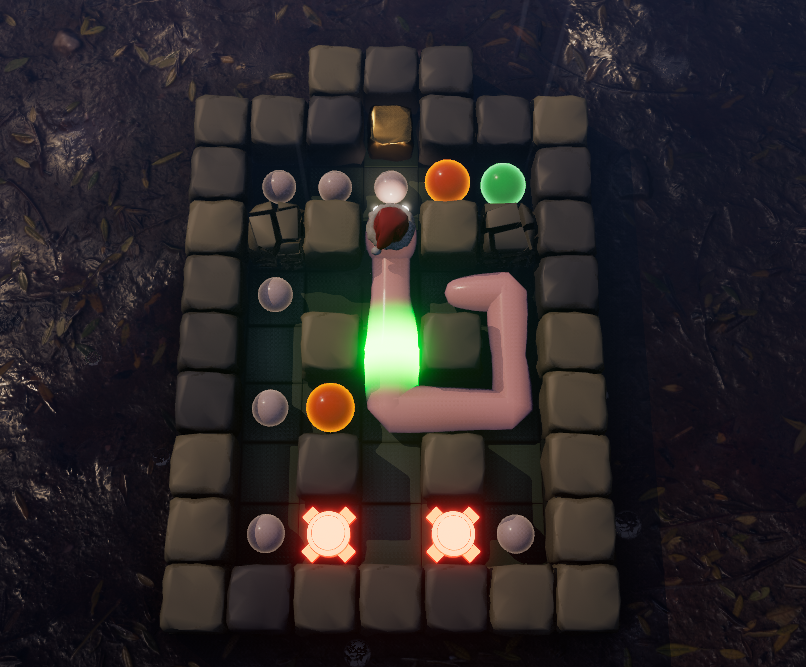
Well, the game started as a game jam entry. The theme of the jam was “extra life”, so I thought it made the most sense to have that be part of the game’s core mechanics, ie. being able to control your size by using extra lives strategically. I thought a worm would be a better fit than a snake, since worms are known to be able to regenerate their tail (it’s the head in the game, but minor detail…) Worms also come out on rainy days and since nothing goes together better than smooth jazz on a rainy day, it all kind of just came together nicely.
I ended up winning the game jam, and decided to spend the winnings turning the prototype into a commercial product. It wasn’t a big budget, but I did hire a jazz composer for the soundtrack :). I wish I had spent more time on visuals and level design/difficulty tuning especially. I kind of opted for the easy way out by providing 1-3 stars rather than trying to properly balance it out. I think the thing I’m happiest about is how the sound design turned out.
-Yu
Serpent Fusion by Ramsey Boyce
The basic snake mechanics in this game are like a mixture of those in Vertebrae, Bottom Feeder, and Boa. As in Vertebrae you can move backwards, which translates the entire snake body in that direction. As in Bottom Feeder, your tail attaches to new snake segments when adjacent (though here your tail must also be facing the new segment). And as in Boa, you are sometimes required to cross over water by always having part of the snake on land. Fusion in the name doesn’t refer to the aforementioned hybrid, but the surprising and creative inclusion of picross-like units, which require a certain number of colored segments in a given direction in order to move. These units may be blocking your path, or they might be part of the snake itself! There is also a cute world-map where you control a snake composed of all the levels you’ve completed.
Initially I wasn’t expecting too much from Serpent Fusion, since the graphics are basic, it’s free on Steam with very few reviews, and in the description it was noted that the designer is 16 and created the game as a hobby while in highschool. Well, I was proven quite wrong by this impressive youngster! The mechanics all work well together, which is quite a feat given their unusualness and complexity. The puzzle quality is high - most puzzles have a clear purpose and represent those purposes well. Difficulty is fairly even for most of the game, then jumps up a bit for the last 6-7 levels, some of which were added recently as a free update.

Serpent Fusion is my first published videogame. I’m a big fan of puzzle games and wanted to try my hand at creating one - working on it made me think a lot about what makes a puzzle fun, versus frustrating. I prototyped five other game ideas before making one I liked!
-Ramsey Boyce
Wriggle by Andrea Gilbert
At last, the first snake puzzle game ever created has returned to the internet! As I mentioned in my description of Wriggle 3D above, the idea was inspired by sliding block puzzles such as Rush Hour. The modification from in-line movement to snake movement really adds a new dimension to this style of puzzle, and it birthed the genre that inspired me to write a ~100 page article!
Interestingly, although the goal in Rush Hour is to navigate a special car to the exit, that goal was only used in the later wriggle variant called TJ-Wriggle, designed together with Tom Jolly. In this first Wriggle game, the goal is to arrange the snakes onto tiles of matching color. Having this goal allows for puzzles where the snakes need to move all around the grid, perhaps multiple times, in order to squeeze their bodies into exactly the right shape. The objective is robust enough that no walls or other obstacles are needed, just a rectangular grid filled with snakes. The puzzles are separated into categories of single snake and multi-snake. The multi-snake puzzles are slightly more complicated, but in both sets you get the experience of wrangling very long snakes, something that is both frustrating and delightful.
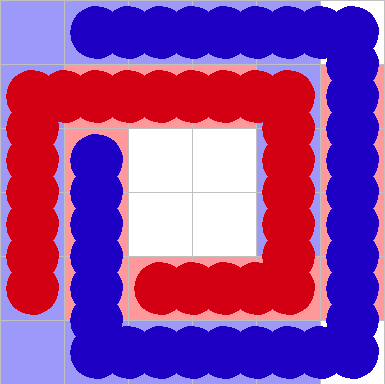
Colour-Wriggle Mazes by Andrea Gilbert
A curious combination of wriggle logic and maze logic, these puzzles task you with wriggling from the left column to the right column, with no walls or other snakes to get in your way. What does restrict your movement is that at each step you must be sitting on all different colors. Had snakes only been able to move from their head, this would have resulted in a fairly straight-forward maze where paths are readily deduced. The ability to wriggle from your tail makes it more complicated than that, and my first reaction was sheer surprise at how easy the maze should be, but is not. When I arrived at the middle of the puzzle pack, I found it difficult enough that I meticulously traced out intermediate states stemming from the start and end positions until they met in the middle. I later found a more efficient strategy, though it still didn’t make the puzzles quick or easy. Be careful not to spend too much time on this in one sitting, as it can strain the eyes a bit.
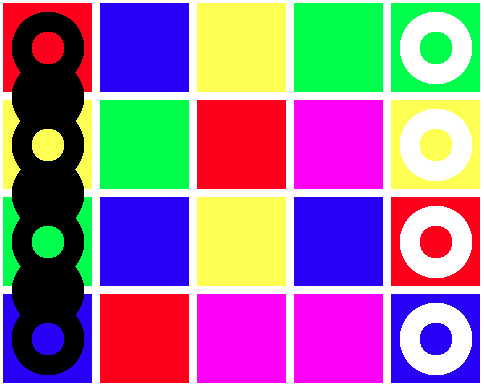
TJ-Wriggle by Andrea Gilbert and Tom Jolly
In this version of Wriggle, the goal has changed to getting the blue snake to the exit in the bottom right. This makes it feel a bit more like Rush Hour, in that getting other snakes out of the way tends to be a larger focus than wriggling into an exact shape, though of course there is significant overlap. More differences in the puzzle style include stationary walls and on average shorter snakes; these make for puzzles that feel more intuitive in their logic - you’ll be thinking of where to put the different snakes and how to order their maneuvers, in place of the more unique but less intuitive wriggling of huge snakes (though there are still a few long snakes in this puzzle set). These puzzles are quite similar to the ones found in Wriggle 3D, which polished the style even further. There is no overlap in the puzzle sets: Extreme TJ-Wriggle (below) is all on a 4x4 grid, this set is all on 6x6, and Wriggle 3D is on 5x5. An added treat in this set is the giant BIG-wriggle Challenge, which though it looks very intimidating is actually fairly logical and fun.

Extreme TJ-Wriggle by Bob Henderson
This is an extra set of puzzles for the TJ-Wriggle mechanics, developed by Bob Henderson using a procedural generation method that he describes on the webpage. Despite limiting the grid to 4x4, Bob and his computer assistant managed to find many difficult and intriguing puzzles. The puzzle pictured below requires an amazing 73 steps to solve, despite being so compact. (Andrea tells me that the most complicated puzzle for its size on the clickmazes website is in the game BoxUp, for which Bob Henderson found a puzzle requiring an incredible 153 steps on a 4x3 grid)
Though I did not find all the optimal solutions yet to this set, it is interesting to note the different counting method used here compared to Wriggle 3D. In Wriggle 3D you are tasked with optimizing the wriggle-count, which increases by 1 each time you grab a snake end and drag it by any distance. In contrast, for these puzzles Bob decided to use total-unit-drag. He explains that when he generated puzzles to maximize the required wriggle-count, the result was puzzles with a single empty space such that maneuvering the snakes took a large number of single steps. Instead he generated puzzles that maximize the required total-unit-drag, and found them to be the most interesting. The one small downside that I see with the approach he took is that it’s a bit less fun to find the optimal solutions than it was in Wriggle 3D (or pershaps I just needed an excuse to not find them all this time).
Looking at a tiny grid of snakes, you would expect that getting one snake to the other end would either be very easy or it would be impossible, so it is quite charming to see the solutions unfold in an intricate, and sometimes unnatural, way. Especially amusing is when you start the puzzle, follow a path of several clearly forced moves, and then find yourself… stuck? The puzzles are grouped into 4 sets by the number of snakes that they have, and are ordered in decreasing difficulty. I played them in that order and thought it was fine, since the difficulty doesn’t vary too much, plus you get the bonus of feeling great after solving the first puzzle. Andrea recommends the 2-snake and 3-snake sets, and I think I would add in the 4-snake set too. The single snake set is a bit funny, you’ll see why if you go through a few of them.
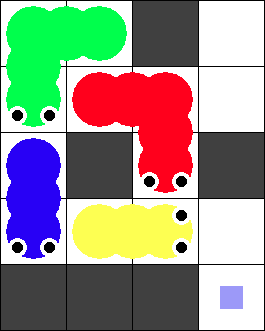
Snakeoban by TeamDoodz
Made for a 72-hour game jam with the theme “Limited Space,” as the name suggests this Snakeoban has you pushing boxes onto targets. Unlike the previous games of the same name, in this one your snake has indefinite length. There are a few alterations to that basic concept, such as not leaving snake segments behind when you wade through water. The game has some decent puzzles, though none of them spectacular like the last two levels of Bottom Feeder. It also suffers from loud background music and no undo button.
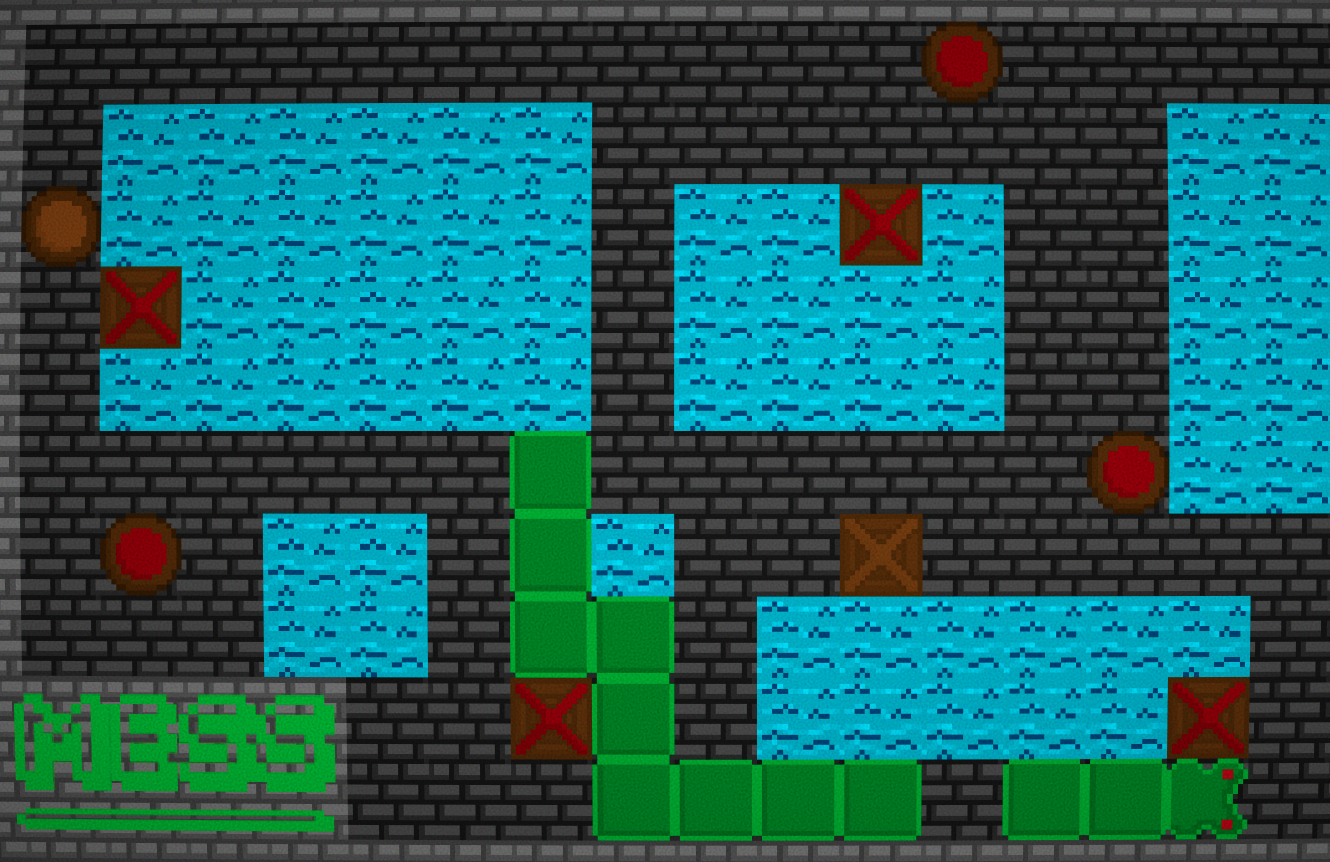
Mortal Snake by UMD Puzzle Hunt
Ryan Thomas crafted this clever snake game for the 2021 UMD Puzzle Hunt (an annual event that I participated in for the first time this year). Saying anything more would ruin the intended experience of figuring out what the goal is, but feel free to send me a line if you’d like a hint to help get you started.
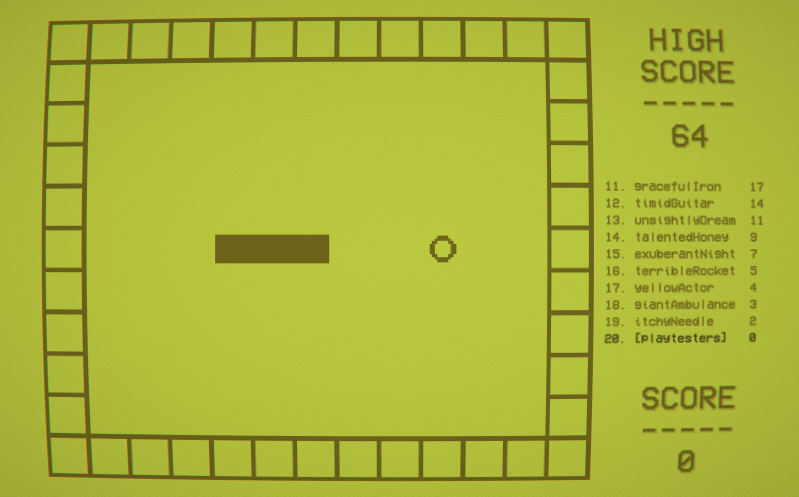
Room to Grow by Mischka Kamener
This long awaited snake-cactus crossover game expands brilliantly on the mechanic earlier seen in 8 Happy Snakes (though not known to the designer). The player grows a cactus in snake-like fashion, and can push off walls to translate its body in that direction. The goal in each puzzle is to place cactus pots onto properly cactus-nourishing circles, and this is accomplished by pushing them either directly with your cactus head, or with your body as you bounce off walls.
What could cacti have over snakes? This philosophical question has not been given a clearer interpretation since Nietzsche exclaimed “ow, that thing is pokey,” and by the end of Room to Grow you will wonder why the answer didn’t come to you in time for your PhD defense.
The art and sound design make for a beautiful experience, and the puzzles are delightful as they progress gradually in difficulty and mechanics. For the most part puzzle solutions are logical and elegant, though I found near the end that I needed to use some trial-and-error.
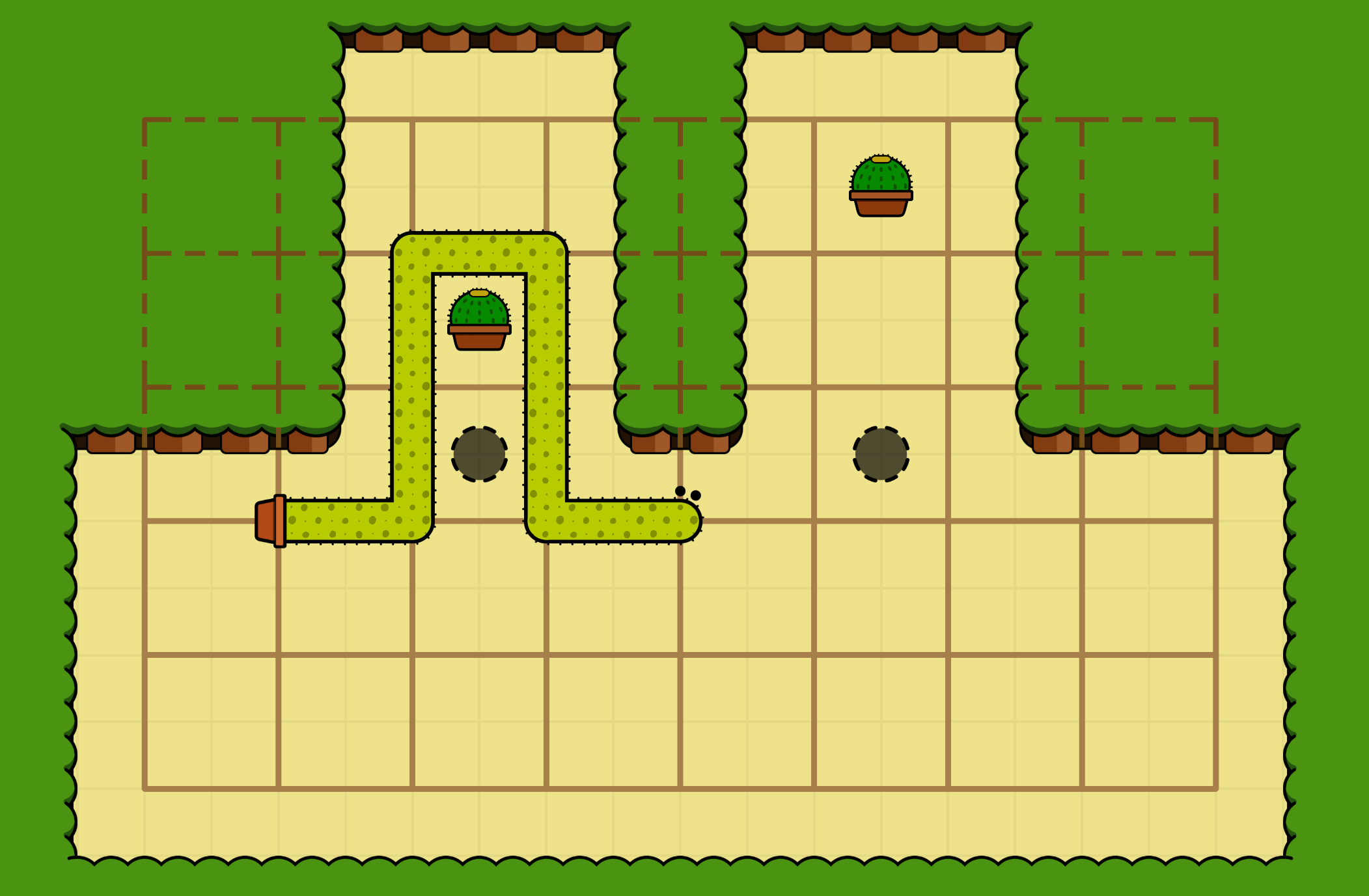
Editor’s note: the text below should not be considered factual
What do cacti have over snakes? There are so so many things! But for the sake of time, here are two:
1) Cacti are a much better metaphor than snakes for the mechanics in Room to Grow. Plants continuously grow from a source point, while we all know that snakes only grow when they eat fruit. Additionally, cacti are much more rigid than snakes, which helps explain why you keep your shape when pushing against a wall in Room to Grow.
2) Cacti are underrepresented in videogames, often relegated to being environmental extras. Snakes on the other hand (as this extensive list shows) have been overwhelmingly cast as the main character, particularly in puzzle games. Thus, not only are cacti more deserving of having a leading role, but by having a succulent protagonist, Room to Grow is able to stand out more from the crowd.-Mischka Kamener
Shall We Golf? by Nebu Soku
Have you ever wanted to make a conga line with all your golf friends, share a single club among the whole group, and take turns smacking each other with the ball? Strange as it sounds, these mechanics make for a much more interesting game than Old Golf. Snake your players around the green so that you can stop the ball in just the right position for the final putt.
While infinite length snakes sometimes feel like line-drawing instead of snake-moving, a temporal element will often bring the snake to life. Shall We Golf has you hitting the ball from anywhere on your body, and you will often need to alternate hitting the ball with growing the snake further in order to reach the hole. Look out for some of the most beloved (by a small subset of people) golf terrain features as you progress through 15 satisfying puzzles.

The only thing I can add is that the Japanese title is a parody of a famous Japanese game. (This is unimportant information. There is no need to actually add it.)
-Nebu Soku
Upaon: A Snake’s Journey by Wired Dreams Studio
Upaon describes itself as a casual puzzle game mixing Snake with Sokoban, but I would add that its main focus is on ice (sliding) movement. Like Snakes without Brakes above, the goal is to slide around the level and eat all the fruit. One difference is that in Upaon, running into your tail results in having to restart the level, rather than stopping yourself to ricochet in another direction. I found that to be one of the more interesting interactions between snake and ice mechanics, so it feels missing here.
Mechanics are added along the way, including trap floors that you can only pass over once, and crates that you can push a single space at a time (instead of sliding like the snake usually does). Puzzle design is on the casual side, in the sense that there are multiple solutions to most puzzles, and they are intended to be solved in quick succession.
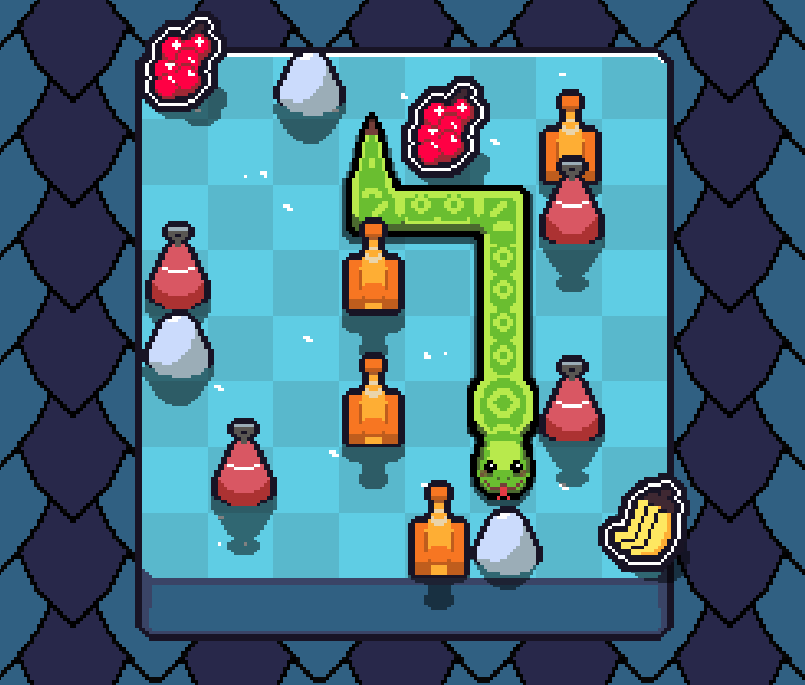
Snake Dance by Dom Camus
Snake Dance is a single level puzzle that was part of the 2021 Confounding Calendar, a collection of new puzzles from various designers to celebrate the winter holidays. In this game, you control a person who- wait, you don’t control a snake? Well, part of the charm of each submission to the calendar was supposed to be figuring out the rules, so I won’t spoil them here. I really like how they work though! Perhaps there weren’t too many more puzzles to be made from these mechanics, but the one presented is certainly fun. ElectronDance rated the difficulty as juggling chainsaws, though in my opinion it’s mostly the intimidation of being plopped in a large level without first getting the hang of the rules and techniques. A mysterious user going by the pen name “Jom Fomus” made a follow-up puzzle called Snake Prance. The difficulty is purportedly juggling chainsaw jugglers.
If you’re looking for more puzzles, my other two favorites from the Confounding Calendar (though the whole project is good) are SokokoS by Notan and Every Star Needs a Tree by Toombler. If you liked Snake Dance then consider Dom Camus’ major puzzle game The Golem, which is fantastic (but I may be biased).
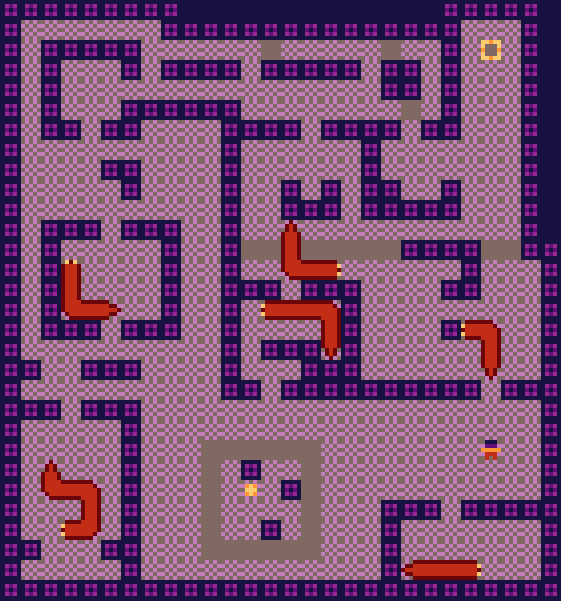
The idea for it came about because I was thinking about multi-character control systems in general and how block pushing games with different shapes in them can sometimes feel like multiple characters with an indirect control system. Once I had the idea of snakes which move when you push any part of them, the rest was just exploring that design space a bit.
-Dom Camus
Awards
There are many great games above, and it’s hard to leave some of them out when highlighting just a few below.
Best overall game: Snakebird
Deepest and most challenging: Vertebrae
Best original mechanics: Snakehole, Tail of the Serpent, SnakekanS
Best snake games that are not snake games: Puddle Knights, Shackle
Honorable Mentions:
Snakeoban (Jack Lance) – excellent puzzle design
Lime Rick – interesting mechanics and levels
Wriggle 3D – elegant optimization puzzles
Snake Slider – good optimization puzzles with more complex mechanics
Snakefall – good to great fan-made levels for Snakebird
Bottom Feeder - excellent concept and puzzles
Worm Jazz - highly polished with interesting mechanics
Serpent Fusion - nice puzzles result from a surprising combination of mechanics
Room to Grow - beautifully done, interesting concepts
Work particularly well for mobile / touch controls: Snake Slider, Quetzalcoatl, Snake’s Tale
Most humorous: Trifecta of snake games by Dario Zubović - SnakeShit, ShitStain, Train Snaking
Ultra-Handy Quick-Reference Table
| Game | Author | Published | Description | Difficulty | Num levels | Price | Platform |
|---|---|---|---|---|---|---|---|
| Wriggle | Andrea Gilbert | May 2003 | Wriggle into place | Medium - Hard | 20 | Web, non-mobile | |
| Puzzle Snake | Kroum Grigorov | July 2006 | Eat and exit | Easy - Medium | 8 | Web | |
| Colour-Wriggle Mazes | Andrea Gilbert | Aug 2006 | Wriggle through color maze | Medium - Hard | 9 | Web, non-mobile | |
| TJ-Wriggle | Andrea Gilbert, Tom Jolly | Aug 2007 | Wriggle to exit | Medium - Hard | 11 | Web, non-mobile | |
| Wriggle 3D | Andrea Gilbert, Tom Jolly | Sept 2009 | Reach exit in optimal moves | Easy - Very Hard | 80 | Mac OS | |
| Extreme TJ-Wriggle | Bob Henderson | Dec 2010 | Wriggle to exit | Medium - Hard | 80 | Web, non-mobile | |
| Snake Slider | Bas de Reuver | July 2011 | Reach exit in optimal moves | Medium - Very Hard | 75 | Web | |
| Filler Snake | Jaberish | Mar 2013 | Fill all squares | Medium | 31 | Web | |
| Lime Rick | Tommi Tuovinen | Aug 2013 | Reach higher by stepping on self | Medium - Hard | 38 | Web | |
| Snakeoban | Wayne Myers | Oct 2013 | Snake + Sokoban | Easy | 10 | Web | |
| Wriggler Demake | Ardeej | May 2014 | Fan version of Wriggle | Medium | 14 | Web | |
| Quetzalcoatl | 1button sarl | Nov 2014 | Match colors | Easy - Hard | 180 | $2 | iOS |
| Unconventional Guns | Rectangular Tim | Apr 2015 | Snake gun | Medium | 15 | Web | |
| SnakePace | LogicalCell | Apr 2015 | Move backwards | Medium | 15 | Web | |
| Snakebird | Noumenon Games | May 2015 | Eat to grow + gravity | Medium - Hard | 51 | $7 | All |
| Snakeoban | Jack Lance | June 2015 | Snake + Sokoban | Hard | 23 | Web | |
| Snakebird fan edition | NohatCoder | July 2015 | Fan version of Snakebird | Hard | 6 | Web | |
| Snakefall | Josh Wolfe | July 2015 | Fan version of Snakebird | Medium - Very Hard | 95 | Web | |
| Avis Anguis | Terzalo | July 2015 | Fan version of Snakebird | Hard | 6 | Web | |
| Lime Richard | Richard Dyer | Sept 2015 | Fan version of Lime Rick | Easy - Medium | 10 | Web | |
| Dotsnake | Franklin Dyer | Sept 2015 | Eat all the dots | Easy | 12 | Web | |
| Snortal | Increpare | Nov 2015 | Snake + Portal | Hard | 1 | Web | |
| Snake Blocks | Spooky Cat | Dec 2015 | Connect pairs in 3D | Medium | 50 | $5 | Win/Mac |
| Tile Snake | Andrew Tollett | Apr 2016 | Fill holes with body | Easy - Medium | 14 | Win | |
| Boa | Steven Miller | May 2016 | Adventure through large maps | Easy - Medium | 20 | Windows | |
| Snakebird GB | freeball1 | Sept 2016 | Fan version of Snakebird | Hard | 10 | Gameboy | |
| Snake Escape | Einar Sauskas | Nov 2016 | Fan version of Lime Rick | Medium - Hard | 42 | ZX Spectrum | |
| Snake’s Tale | Michael Fairley | May 2017 | Reach exit | Easy - Medium | 75 | $3 | All |
| Vertebrae | Ali Nikkhah | July 2017 | Move backwards, collect vertebrae | Very Hard | 55 | Web | |
| SnakekanS | Chen Gong, Binxing Wu, Weihao Xie | July 2017 | Eat different animals | Medium - Hard | 50 | $1 | iOS |
| Snake Trail | Steven Miller | Sept 2017 | Snake as raft | Easy - Medium | 12 | Windows | |
| 8 Happy Snakes | Increpare | Dec 2017 | Push against walls | Easy | 8 | Web | |
| Hungry Kraken | Increpare | Dec 2017 | Tentacle snakes | Medium | 1 | Web | |
| Snek alpha + Snek | St33d | Jan 2018 | Control snake with 2 buttons | Medium | 13 | Web | |
| Crate Snake | Steven Miller | Jan 2018 | Wrap around map | Easy - Medium | 18 | Windows | |
| Snake Maze | ZilverPhoenix | Apr 2018 | Escape the maze | Medium | 20 | $0-$5 | Windows |
| der Hydra Krypta | Increpare | June 2018 | Grow extra snakes | Medium | 6 | Web | |
| Shy Snake | Daniel Freer and Increpare | June 2018 | Fill all squares | Easy - Medium | 3 | Web | |
| Ouroboros’ Eggs | Marcos Donnantuoni | June 2018 | Lay eggs inside a loop | Medium | 38 | Web | |
| Snakeshit | Dario Zubović | July 2018 | Snakebird with excrement | Medium | 6 | Web | |
| Shitstain | Dario Zubović | July 2018 | Snakebird with levitating excrement | Medium | 2 | Web | |
| Blocker Snake | Rosden Shadow | Sep 2018 | Even more blocking | Easy - Medium | 6 | Web | |
| Circle Serpent | EvilArtBunny | Nov 2018 | Return to your tail | Easy | 19 | Web | |
| Sokoboros | Trev Newt | Jan 2019 | Keep growing! | Easy - Medium | N/A | Web | |
| Snakehole | Jack Kutilek | Feb 2019 | Snakes can enter holes | Medium | 8 | Web | |
| Snakebird Primer | Noumenon Games | Feb 2019 | Easier version of Snakebird | Easy - Medium | 76 | $8 | Win/Mac/Linux |
| Tail of the Serpent | Le Slo | Apr 2019 | Match symbols on ground | Medium | 25 | Web | |
| Train Snaking | Dario Zubović | May 2019 | Deliver passengers safely | Medium | 9 | Web | |
| Snakey Snakey makes a Sixy | Increpare | June 2019 | Mystery | Easy | 1 | Web | |
| The Turing Snake | edmond00 | Aug 2019 | Snake programming | Easy - Hard | 20 | Web | |
| SNIKS | Shelly Alon | Aug 2019 | Colored snakes overlap | Medium | 110 | $3 | iOS/Android/Win/MacOS |
| Serpent Fusion | Ramsey Boyce | Sep 2019 | Move backwards, Picross | Medium - Hard | 69 | Win | |
| Snake Sokoban Spiral | Justas Dabrila | Oct 2019 | Drop off segments, roll | Medium | 16 | Web | |
| ENIGMASH | Jack Lance | Nov 2019 | Mash of different games | Medium - Hard | N/A | Web | |
| Snakey Jakey | Ethan Clark | Jan 2020 | Push yourself | Medium | 32 | Web | |
| Bottom Feeder | Zach Abel | Feb 2020 | Eat with your tail | Hard - Very Hard | 11 | Web | |
| Snaliens | João Ferreira | Feb 2020 | Boxes, Switches, Circuits, and Snakes | Medium | 92 | $5-8 | Win/Android |
| Puddle Knights | Lockpickle | Mar 2020 | Protect nobles from mud | Medium - Hard | 127 | $13 | Win/Mac/Switch |
| Worm Jazz | Yu He | Apr 2020 | Explode segments and regenerate | Easy - Hard | 57 | $0-7 | Win/Switch/Mobile |
| Anhinga | Nathan Sturtevant | Apr 2020 | Snakebird solver | Hard | 7 | Web | |
| Shackle | Steven Miller | May 2020 | Drag a ball & chain | Medium - Very Hard | 52 | Win | |
| Crocodiles Love Cookies | Ethan Clark | June 2020 | Retrieve cookie with tongue | Easy - Medium | 12 | Web | |
| Monty’s Way Home | Alex Cline | July 2020 | Grow or shrink, then fit inside | Easy | 5 | Web | |
| Snakes without Brakes | Kodub | July 2020 | Sliding snakes | Medium | 20 | Web | |
| Pushy Snake | Tony M | Sep 2020 | Snakebird carrying objects | Easy-Medium | 15 | Win | |
| Volcano Snek | JUSTCAMH | Nov 2020 | Raise lava | Easy - Medium | N/A | Win/Mac/Linux | |
| Snakeoban | TeamDoodz | Nov 2020 | infinite snake push boxes | Medium | 22 | Web | |
| Mortal Snake | Ryan Thomas | Jan 2021 | Puzzle Hunt | Medium | 10 | Web | |
| Room to Grow | Mischka Kamener | Feb 2021 | Grow, push off walls | Medium - Hard | 106 | Win/Mac | |
| Shall We Golf? | Nebu Soku | Mar 2021 | Hit ball with body | Medium - Hard | 15 | Web | |
| Upaon | Thiago Oliveira | June 2021 | Slide and Eat | Easy - Medium | 100 | $3 | Win |
| Snake Dance | Dom Camus | Dec 2021 | Prod Snakes | Hard | 1 | Web |
Games coming in the future
Boa Bonanza
Snake Blocks (awaiting update)
Sausage Dog Tends to Infinity
Sushi Snake was previously published but ran into compatibility issues that are being worked on.
snekoban
Snaklops
Hebi Hebi
SobokoSnake
SnakeOut
Games coming (…to this article) in the future:
Can of Wormholes
Snakoban
A Snake in a Maze
Mini Adventuring Squad
Sneks
Snakebaba
Remnant Labs?
SNEKS
Ssspicy
Greedy Corgi
Snakefice
Tapeworm Disco Puzzle
Martenitsa
Snake on Ice
Snakey Snake
SNAK’
Snug Snek
Shed Skin Eat Egg
Not that Common Egg-Eater snake
Clever Snake Game
Pipi Linja
Lime Larry
Growmi
Taileater
Speleomorph
Snakehaus
Tainakel
Maze with an S
PortalSnake
Elephants Hat Cheese
4S in 1
Tough Love Machine
Quetzals & Ladders
Munchy Mammals
Temple Of Snek
Oh No Wrong Room
Blockado
Sideliner
Butteater
The Wormaid
Snake Solver
Woodworm
Unhinga
Walking Dots
Constrictor
Fillsnake
204Snake
Artillipede
Gulping Snake
Worm Game
Kukulcan
Snakeloop
Year of the Snake
BederSNAKE
Snekburd
Snakebird Math
Shack-o’-Lantern
Hebird
Goop Snake
Snekoban
Serpent Circuit
Snekcross
Omissions
The style of game where you need to touch all the squares in a room without revisiting any square is sometimes themed as a snake game. Formally this type of puzzle is equivalent to finding a Hamiltonian Path in a graph, except when there are mechanics in which order matters (like the bombs in Filler Snake), or other oddities like touching multiple squares at once in Shy Snake. The original Hamiltonian Path puzzle is the Knight’s Tour, invented back in the 9th century!
There are several other games of this type that I did not include – the list is long enough already. Here is a quick list of some that I found:
Alcazar was the most popular implementation of this type of puzzle game, but is unfortunately no longer available. Edderiofer wrote a couple of interesting blog posts about techniques in these types of puzzles.
Hamiltonian Mazes changes connectivity from the regular square grid.
Grand Tour Puzzles 1 includes required path segments
Grand Tour Puzzles 2 is currently down because it relies on java applets
Fillall has crossings and a type of lock & key.
Filler has sliding tiles, crossings, portals.
Linemaze seems very similar to how Alcazar was, in appearance and mechanics (I don’t know about puzzle quality but it’s unlikely to be as high).
Overlink plays on a 3D surface.
Lineway looks pretty, and has merged tiles, directional tiles, and some other things.
Line Master Puzzle has lock & key, crossings, direction tiles.
Snakes and Serpents’ Nest both add multiple snakes controlled independently.
Maze Dash uses sliding style movement.
Snakes and Apples adds apples to pick up in a specified order.
Fill the world with your rainbow adds blocks to push around (though it’s a very short game).
Mochi Mochi Boy defies description.
Snek Konnect has a snake but no added mechanics.
Cardinal Chains has numbers on each tile, and the path must take a non-decreasing sequence.
Unium allows crossovers on any tile.
Snake Pit has tiles you must touch twice.
Spacious Snake has tiles that turn into thin walls when touched.
Snake Islands is a standard hamiltonian path puzzle, as a snake.
Blobun has a bunch of extra mechanics.
There are some games that used the same mechanics as Snakebird or Wriggle without mentioning their inspiration, and without new ideas. With Snakebird it seems very likely that the mechanics were copied, while with Wriggle it’s possible that other developers just hadn’t known about it. Too Many Snakes, TruPuzzle, and Twisted Snake have the same mechanics as Wriggle, but came after Wriggle did. I don’t really want to advertise the Snakebird clones but if you are curious I saw this, this, and this
Choo Choo Puzzles is like Wriggle on a hex grid, but also with pushing. It does feel a bit more like moving vehicles around than snakes, but it’s a good concept (or am I just making an excuse to not do more work?). Blockwick 2 is another game with some similarity to Wriggle; it is mostly a block sliding game, but snake movement makes an appearance.
Almost a puzzle is Chnakess, a snake + chess combination where you try to eat all the chess pieces. The pieces will escape your bite if they can move without being blocked by your tail, and if they have multiple options they choose somewhat arbitrarily. This makes it feel slightly more like an arcade game than a puzzle, but it’s worth checking out. (Chnakess has recently been taken down, but I hope it may come back some time)
Slime Path is a game about slimes which probably would have made it if it had snake graphics. You control multiple slimes that act like infinite snakes, with some added mechanics like lock & keys, and you need to get all slimes to their exits. It’s actually not bad, maybe I should have included it…
Another infinite snake but-not-a-snake game is Necroworm. The production value is high but the mechanics are not as interesting as in Slime Path.
The Giraffe and its sequel The Giraffe World are games about extending giraffe necks in a snake-like fashion, though they can cross themselves perpendicularly.
Elephants have long trunks is a game about eating fruit with an elephant trunk. It has a few differences from snake movement, but is very interesting and cute.
Tactical Hand Eye is a short joke-game based on someone’s profile picture in the thinky puzzle games discord, but it’s actually not bad. Involves multiple infinite snakes pushing crates.
Snackzzle technically fits but has some issues with arbitrary lock-key combinations, no undo, and uninteresting puzzles, so I didn’t include it.
Getting Long is a snake game disguised as a cute dog game. You need to eat all the crumpets without getting hit by a snail or spikes. Quite short and only a couple of real puzzles. Another game that would make my list of Dog Snake Puzzle Games is Puzzle Puppers, which has infinite length dogs.
One Level by Dario Zubović has a fun snake puzzle in it, and he made a more challenging Alternate Snake Level as well.
Some puzzles by Rosden Shadow where you leave a trail like a snake, but the rest of the mechanics are different from snake games:
Statues
Electric Wire
Ice Path
Pit Trails
Globule is a puzzle game about a robot guiding a puddle of slime, which acts very much like a two-headed snake would. However, the levels are mostly tedious.
Snek by Nyunesu is a short atmospheric puzzle game made for LDjam47. I will see if there’s a post-jam version before considering adding it to the article. Another short jam game is Snake Game by 17msnow6, which has the simple eat to grow then exit rules. Snake Puzzle Nokia is also a very short jam game with basic snake mechanics.
Snakeformer and Coil are two snake platformer games that feel similar to snakebird, but have different physics and are less puzzly. Dual Snake adds an extra head to the snake platforming idea, and it too has action elements.
Puzzle games where snakes are your enemies:
SnakEscape
DROD (though snakes are not a main focus)
Snake Puzzle Game is a strategy game where you try to outgrow an AI snake, and fruit are generated in predictable locations.
The Serpent’s Shadow has an interesting mechanic, which is that you need to shade an area of ground from a light source using your snake’s body. The puzzles are not particularly deep though and there is a small real-time element.
Snake Pass is a snake game that has puzzle elements, but is overall more of an adventure game.
Also omitted (due to both fundamental differences and my lack of experience) are the Pen and Paper snake puzzles. Snakes in these logic puzzles tend to be contiguous groups of tiles whose shape has width 1 all along its length, and is bordered by empty tiles (ie the snake doesn’t touch itself). The solver is tasked with finding the exact shape of the snake given certain information, such as numbers on rows and columns defining how many snake segments are present in that row or column. Puzzle creators play around with what type of information to give, to keep things interesting. I haven’t gone through enough of these puzzles to make recommendations, but here are some resources I found:
Serkan Yürekli’s Snake and Variations book
GMpuzzles snake collection
Melon’s Multi-Ouroboros puzzles
Puzzle Picnic snake puzzles
puzz.link snake puzzles
Snake puzzles at logic masters germany
Erich Friedman’s chess snake puzzles, and a couple extras
Logic Masters India had snake variations contests in 2011 and 2015, and a monthly set in 2015.
Para’s Puzzle Site (link is to search results for their snake puzzles.)
There is a Nikoli puzzle type called Hebi that is about snakes of numbers, but it doesn’t seem very popular. There is a small example discussed by chaotic_iak.
Jack Lance made one snake puzzle, and here’s a Snake Park by IHNN.
Hempuli’s Ouroboros is somewhat like Melon’s puzzles above, and he has a few more snake puzzles on the blog.
Meandering Numbers is a another obscure genre with snakes, where pre-defined regions must be filled with numbers 1 to N in a snake shape, while not letting equal numbers touch vertically or diagonally with other snakes. Here are some of these puzzles hosted on puzz.link.
Build-a-Snake is a puzzle where you try to find the longest snake possible in a given grid size, using the standard pen and paper snake definition.
Menderbug’s Heyasnake and a variant.
There’s a type of physical puzzle called a snake cube, where you have a long string connecting small 1x1 cubes together in a snake-like shape, and you need to twist the snake into a 3x3 or 4x4 cube. I had one of these to practice on when I was younger, and would pretend that I hadn’t seen them before and then solve it in 2 seconds. There is also the Rubik’s Snake that involves twisting, but it is free-form and doesn’t have a single objective.
Ponder This shared a snake inspired math riddle that I haven’t worked out yet.
Discussion
The motivation for this article came from the astonishingly false realization that “I must have played nearly all snake puzzle games at this point!” My rate of discovery of new snake games came at just the right pace so that I always thought I was nearly done - a state lasting months.
Why are snake games special? I do think they have one advantage, aside from a nice theme, which is that they are easy to manipulate mentally relative to their combinatorial complexity. This somewhat goes for polyomino shapes as well, but snakes are among the most intuitive of malleable shapes. Nick Bentley touches on a related idea, perceptual binding, in his blog post about his game Bug. Some of the enjoyment of solving puzzles comes from an extensive utilization of the mind - thinking deeply, in other words (at least that’s one possible definition. It would make for an interesting discussion but we have more important things to discuss here!). The more aspects of a puzzle that are subconsciously internalized, the more complex a puzzle can be for the same level of exertion. I think there’s a decent amount of variability in how intuitive snake movement is for different people, which could explain the widely differing opinions on Snakebird - not only in how difficult it is, but whether it’s a game about trial-and-error or thoughtful planning. I would be interested in seeing how snakes on a vertical plane (like Snakebird) compare with snakes on a horizontal plane for the same person. (I’ll update you all once I receive grant funding)
The most difficult games to complete were Snakefall, Vertebrae, Snake Sliders, and Wriggle 3D. (but there are also some very hard puzzles in Shackle and Bottom Feeder, as well as a few others)
Snakebird and Vertebrae have among the most deep and interesting mechanics, not only of snake puzzle games, but of puzzle games generally. The fan snakebird levels found in Snakefall are more difficult than the original levels, and demonstrate the depth of the mechanics to an even greater degree. This is not to say the original is deficient in any way. Snakebird makes use of two conceptually rich state-changing mechanisms: eating apples to grow, and gravity. Each of these allows many lines of logical argument – how long does a snake need to be in this position (defined by where it can travel with the limitations of terrain and gravity) to accomplish what I need it to accomplish? And further, what combinations of snakes of different lengths do I need to achieve a more demanding goal? One of the definitions of depth in puzzles is that there are conceptual sub-goals to plan out in service of solving the puzzle as a whole, and both gravity and apple eating allow for rich sub-goals. These factors are discussed a bit by extratricky in his blog post, that includes some words about snakebird.
I didn’t want to spoil the mechanics of Vertebrae too much in my description of it above. At first it sounds like all you do is push boxes onto buttons. Oh and you can move backwards, how much could that affect things? The awesome possibilities are revealed to the player soon enough, and explored with great success in the levels that follow. There are many challenges that are conceptual rather than technical – you might feel like you need to do some impossibly precise maneuvering to solve a puzzle, when the solution is instead based on a brilliant new idea. There are also some impossibly precise maneuvering puzzles ;). Vertebrae has more “oh that’s how!” moments than any other game on this list, and is perhaps the hardest of these very difficult four games. (As an update, more complex levels were added to Snakefall recently by Gooby and Karoo13, and I think it has now equaled Vertebrae in raw difficulty to complete.)
Wriggle 3D and Snake Slider have nice puzzles that are made more challenging by asking for the optimal solution. Many puzzle solvers find this a cheap way to increase difficulty, since it could be added to any grid-based puzzle out there, and usually will not make it more interesting, just more time consuming. This criticism is often accurate, but in certain types of puzzles it actually becomes more interesting having to find the shortest solution. This is true in the great board game Ricochet Robots, and I would argue also in these two snake games, though I still don’t think they will be for everyone. Trying to find the shortest solution can be frustrating, since it’s often not clear what part of the solution you need to improve. In a more traditional puzzle, the challenge of the puzzle is presented clearly to the solver; the most satisfying puzzles are often ones that immediately evoke a “this is surely impossible.” But in finding an optimal solution, you are not given the problem up front, and have to find the problem first of all. Is there a part of your solution that could be improved? Is there an entirely different approach that might work better? This can be good and bad. In the best case, it is exciting to discover an elegant tactic where you didn’t think one existed, or a completely new way to solve the puzzle. It can also be exhilarating playing out a new solution idea, and seeing as you get closer to the finish whether you’ll make it in the lowest number of moves. In the worst case the solver must resort to brute force, checking all reasonable combinations of moves until stumbling upon the shortest sequence. This unfortunate event is often caused by a lack of ‘understandability’ of the puzzle, so to speak. The more intuitive or conceptual tools a solver has, the less trial and error they will need to use. I was quite impressed with the two games mentioned here, whose puzzles keep the solver engaged and thinking conceptually, while searching for the optimal solutions. There is something oddly satisfying about maneuvering snakes efficiently.
As a final note, I will aim to answer the age-old question: Can a snake move into its own tail? The answer, as given by the applicable games above, is no! (by a count of 21 to 15) I suspect that part of this is due to the small nuisance of programming it. Curiously, in Snakebird there is a bug whereby a snake cannot normally move into its tail, but it can move another object into its tail. The reverse situation is present in Snake Slider, where a snake can normally move into its tail, but cannot push a different object into its tail.
